
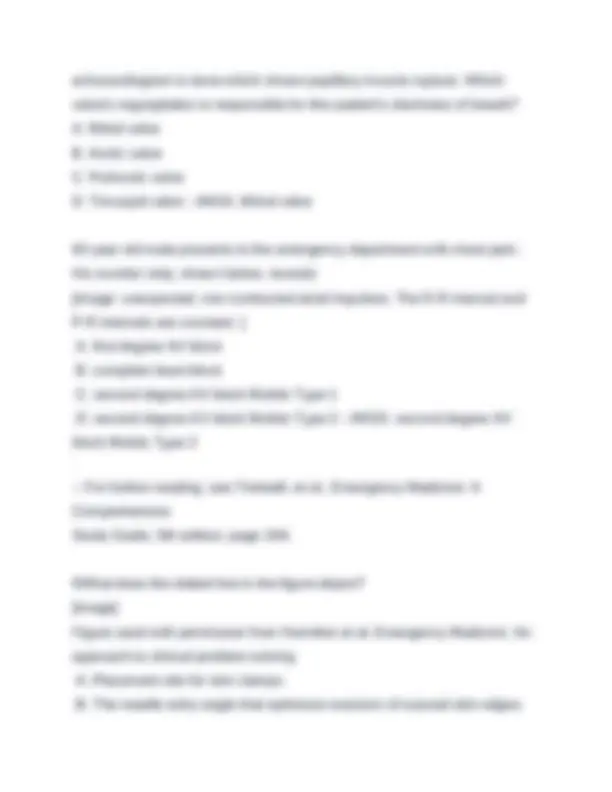
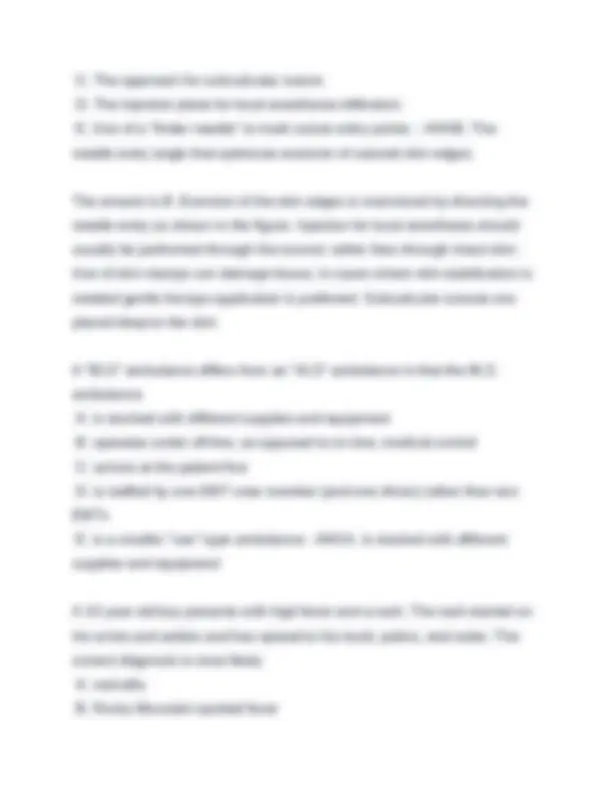
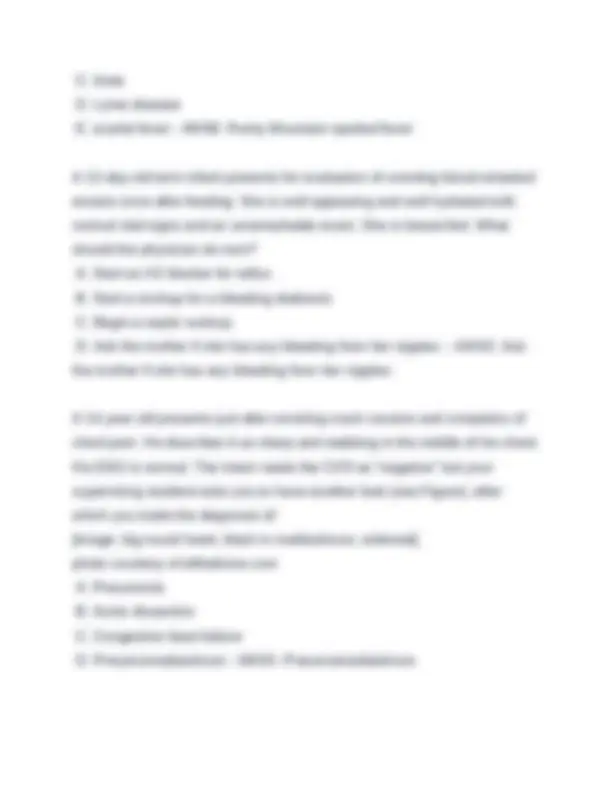
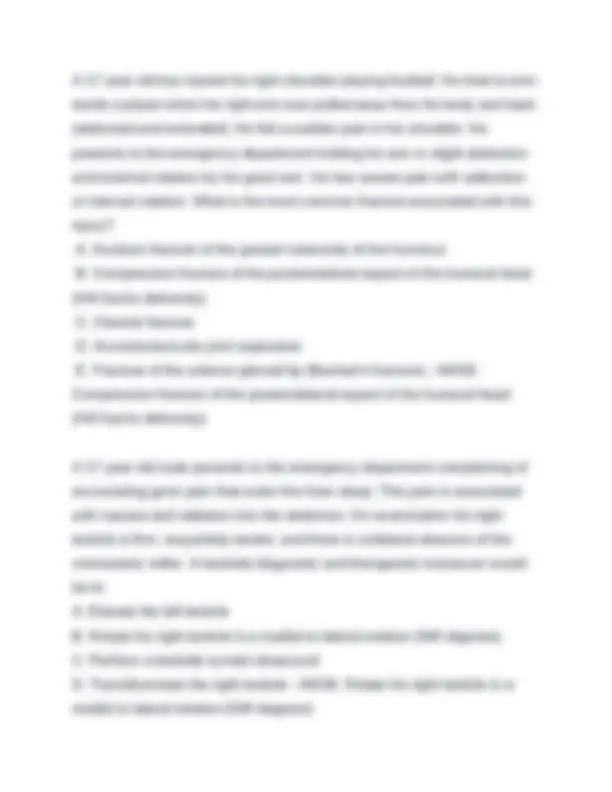
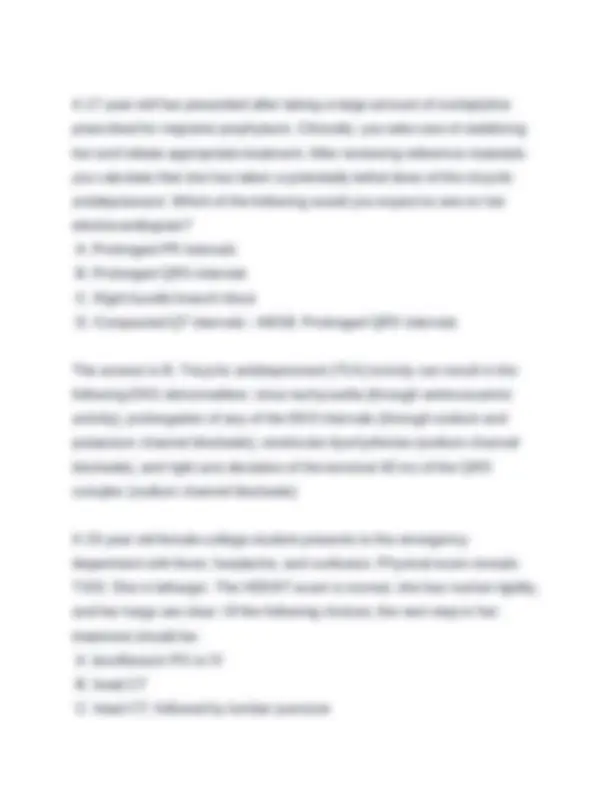
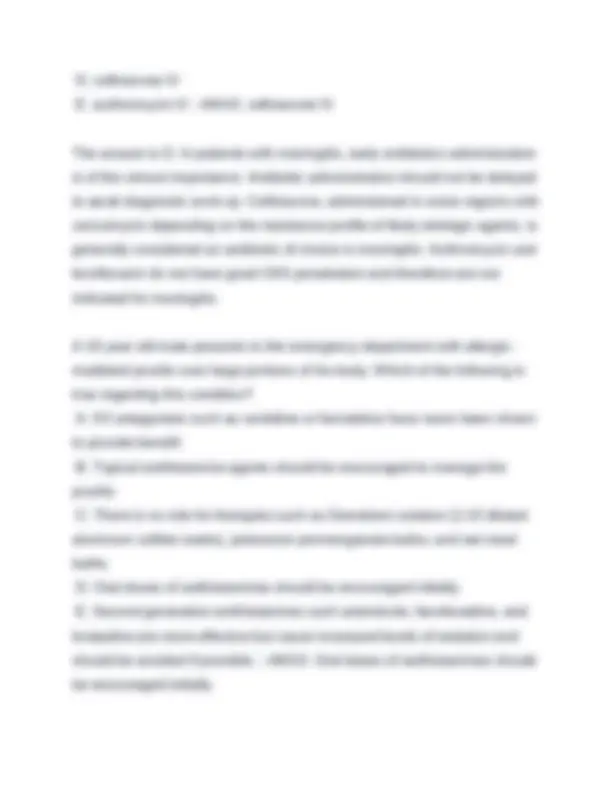
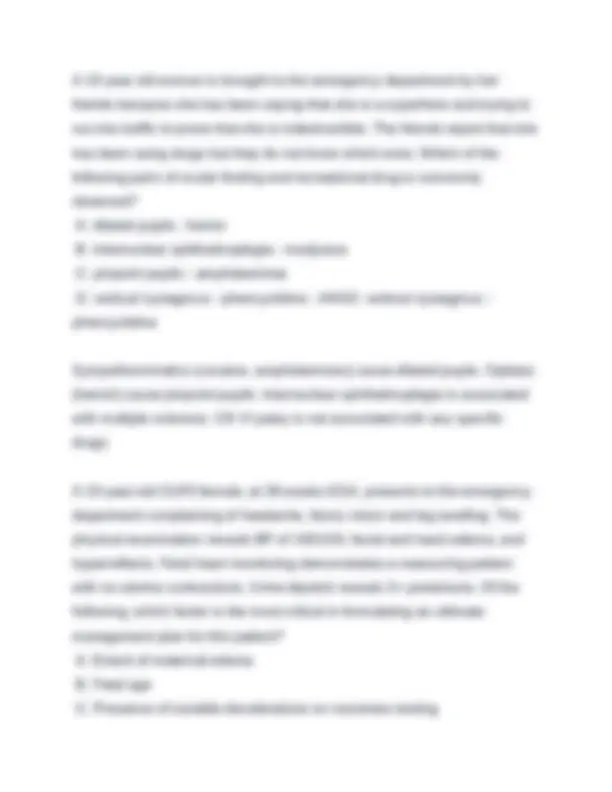
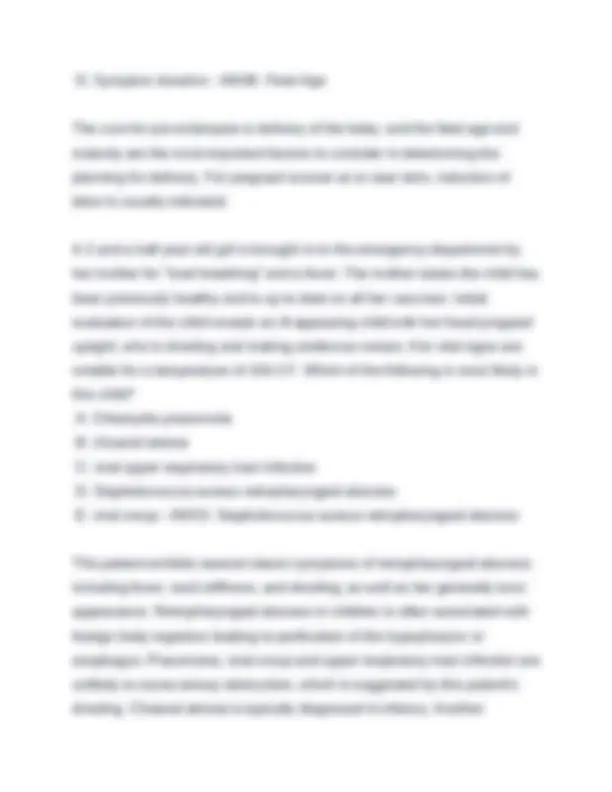
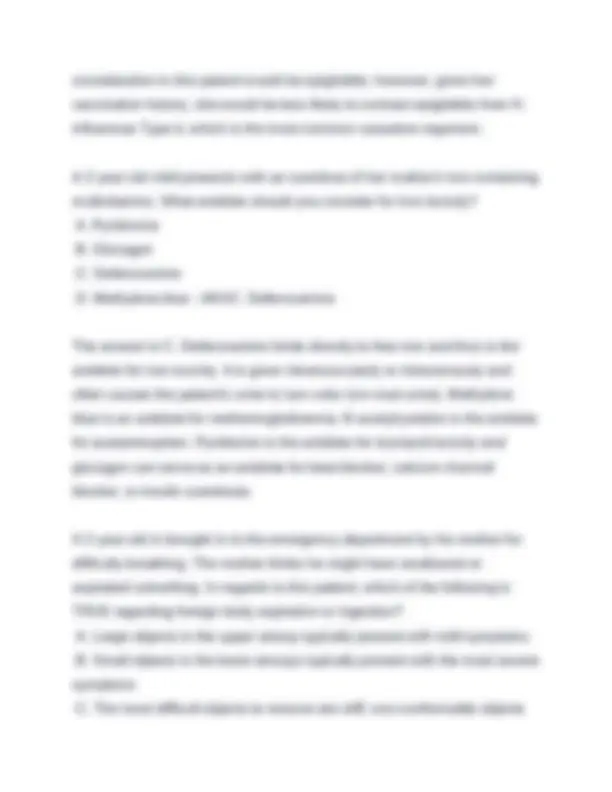
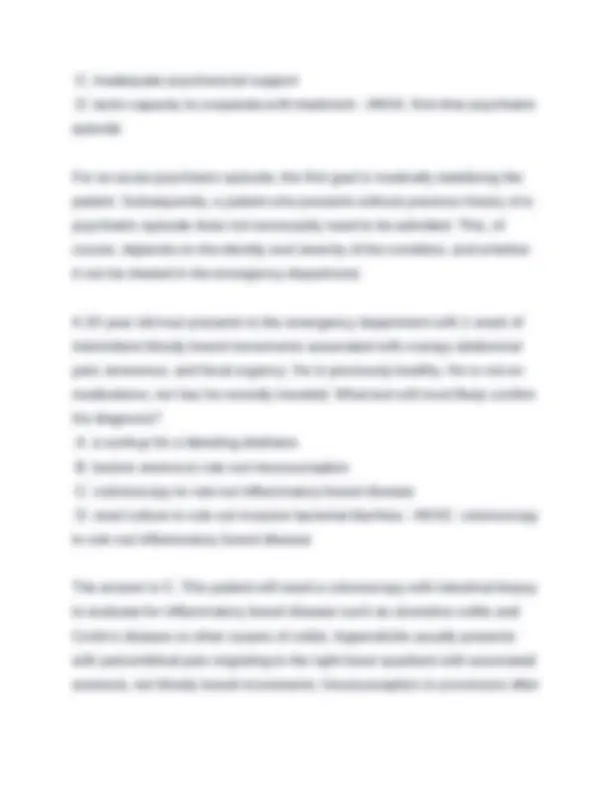
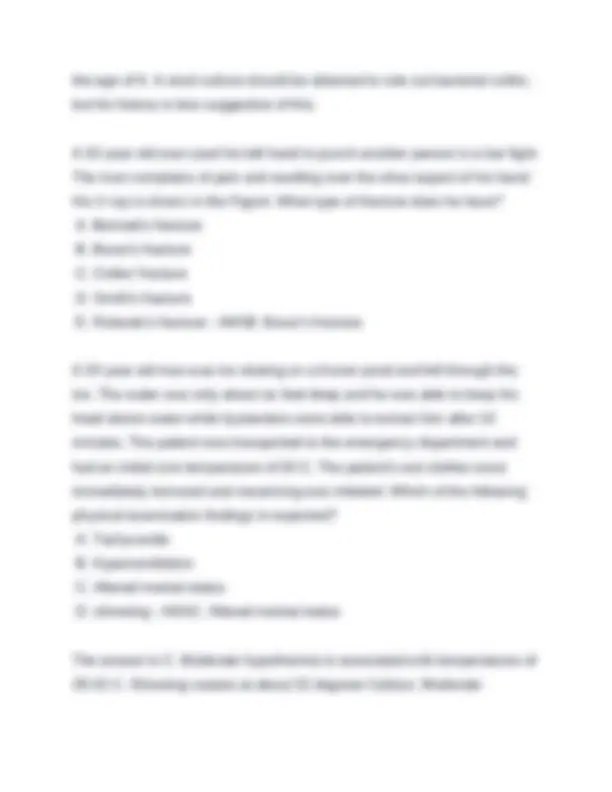
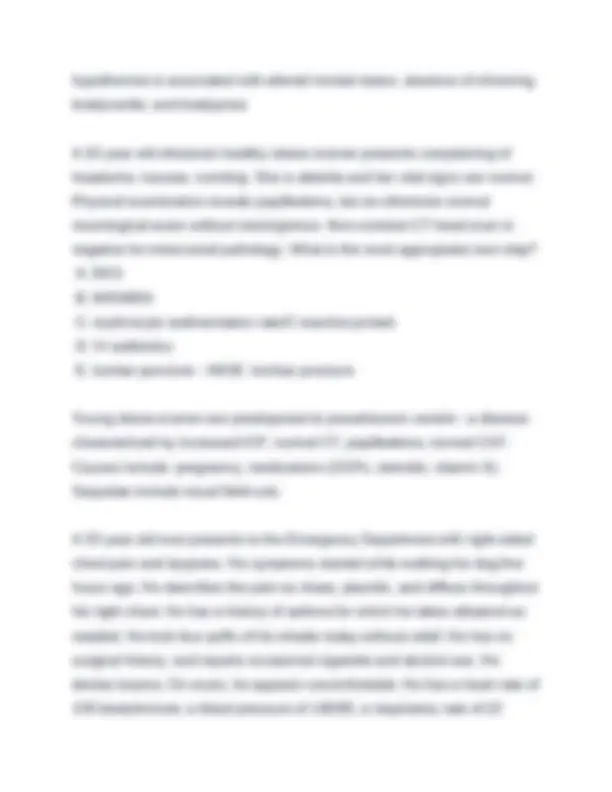
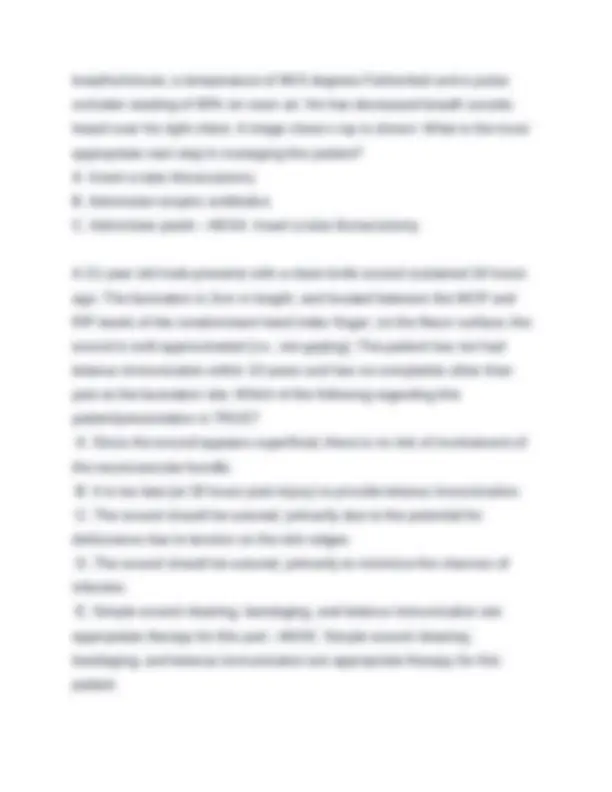
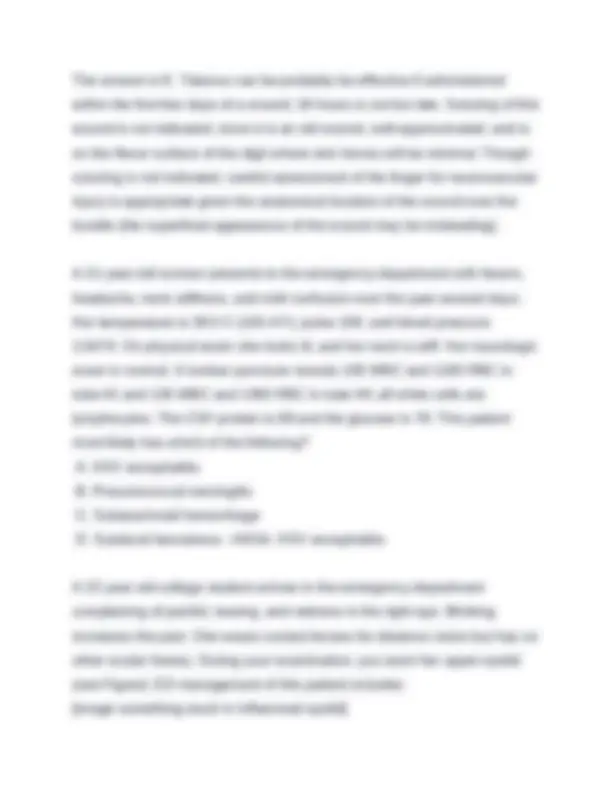
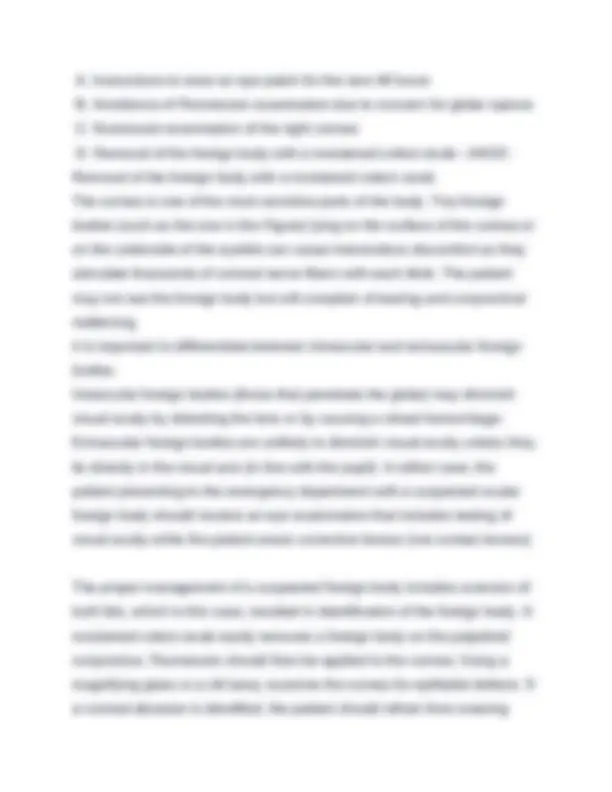
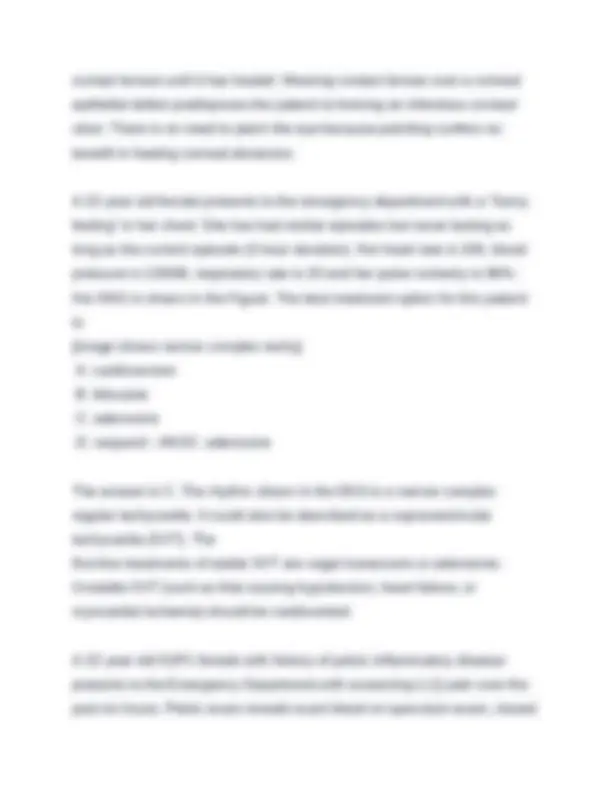
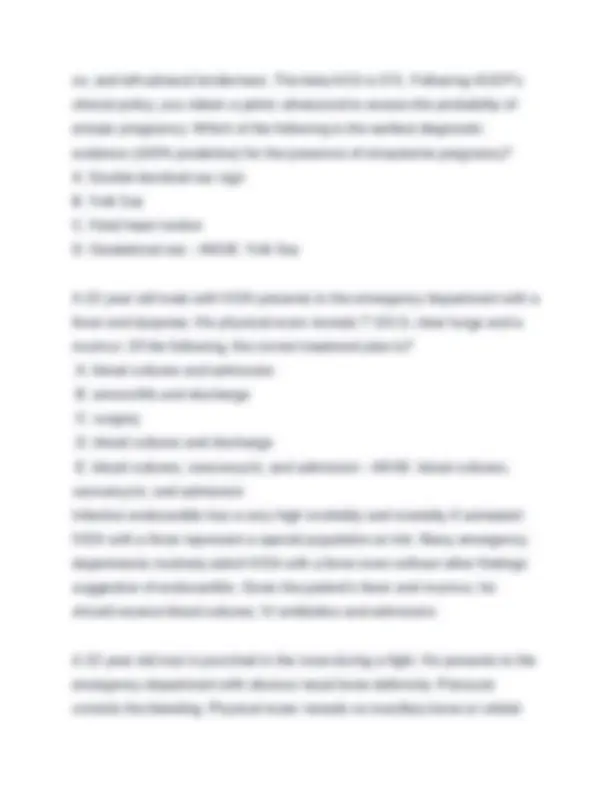
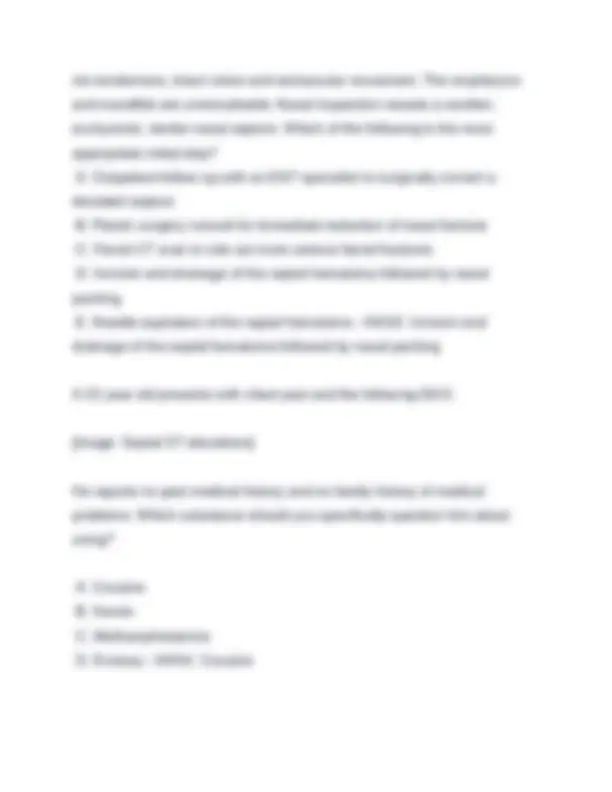
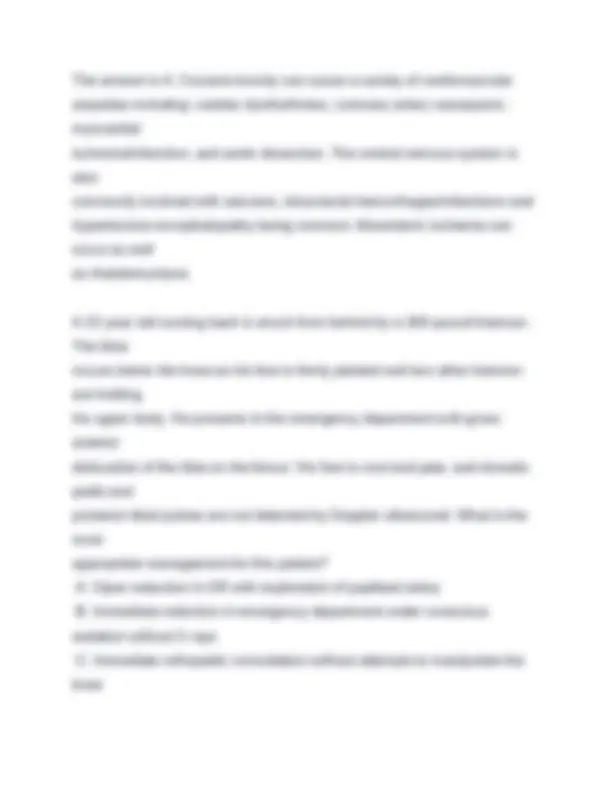
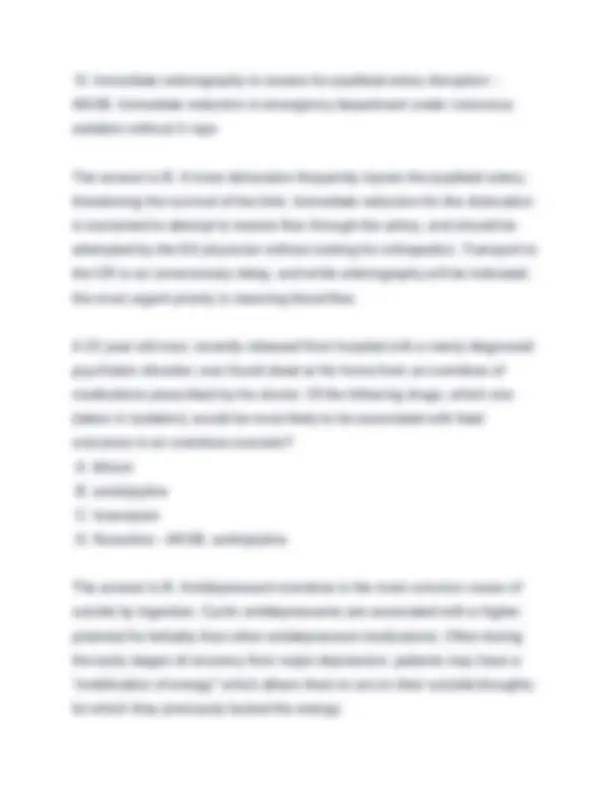
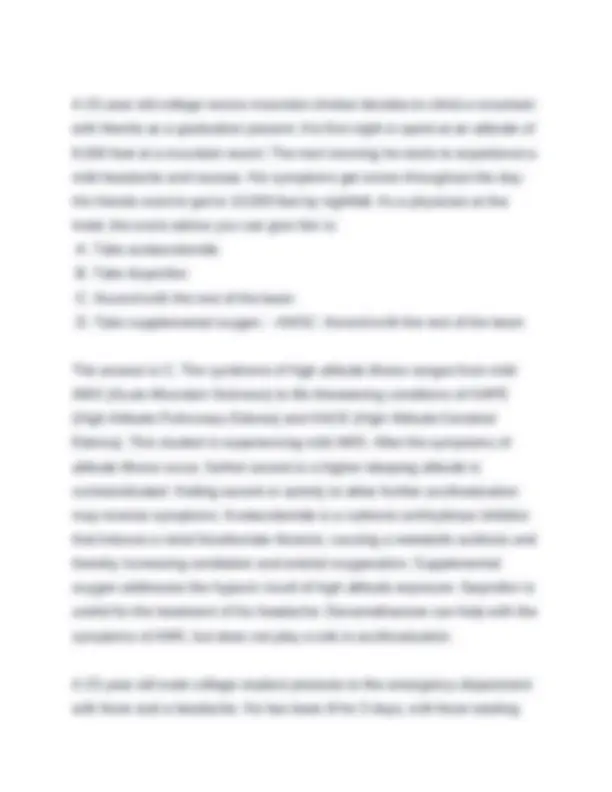

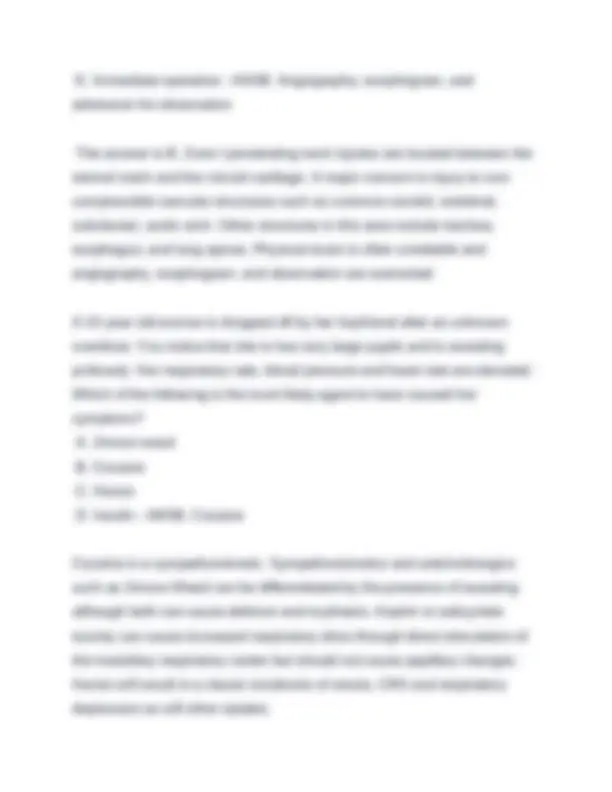
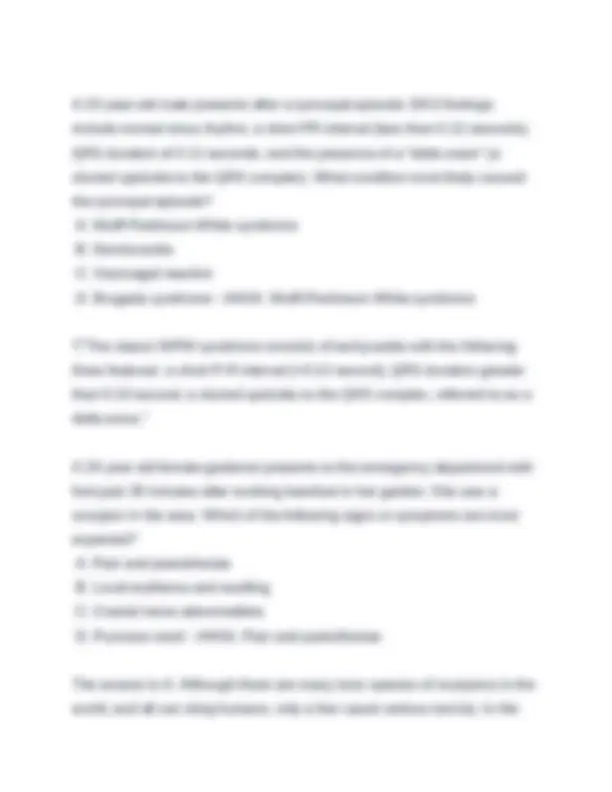
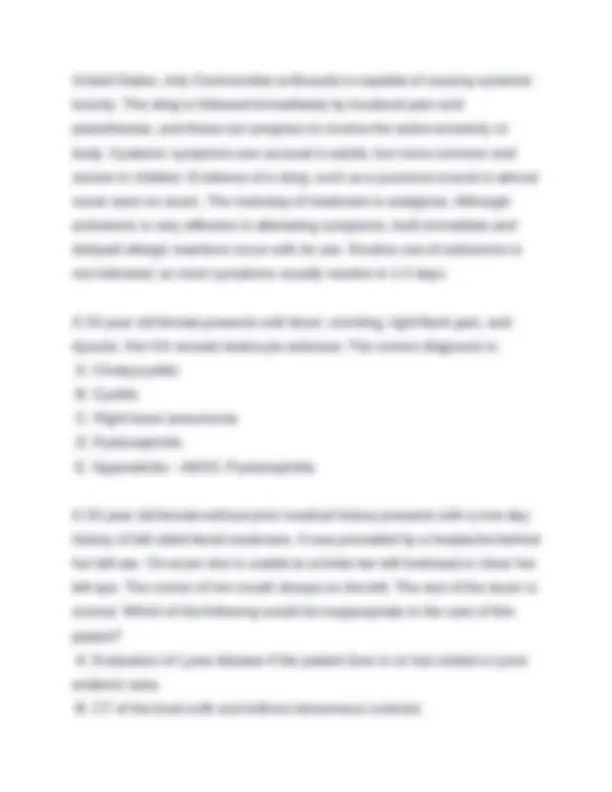
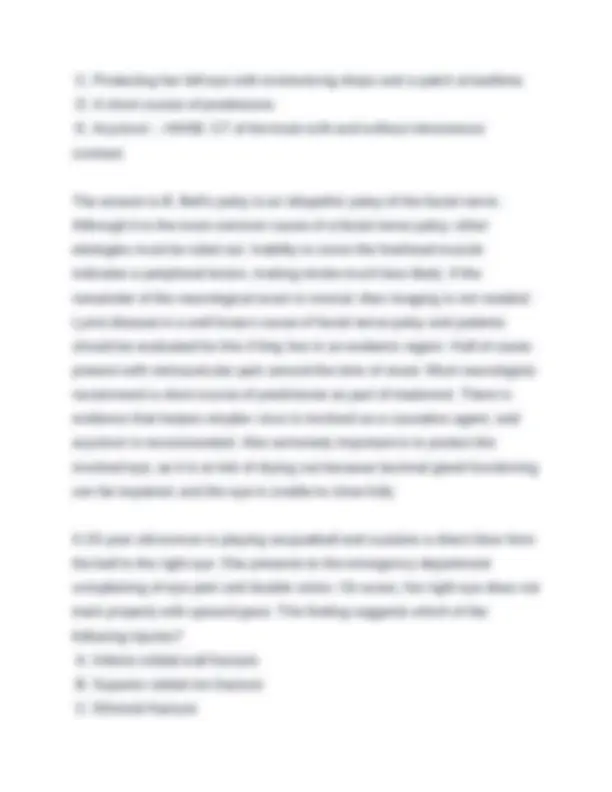
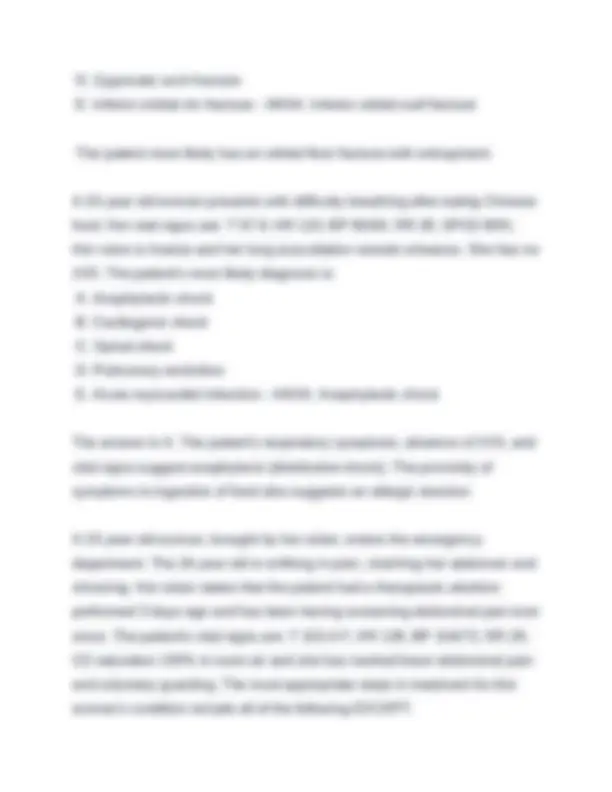
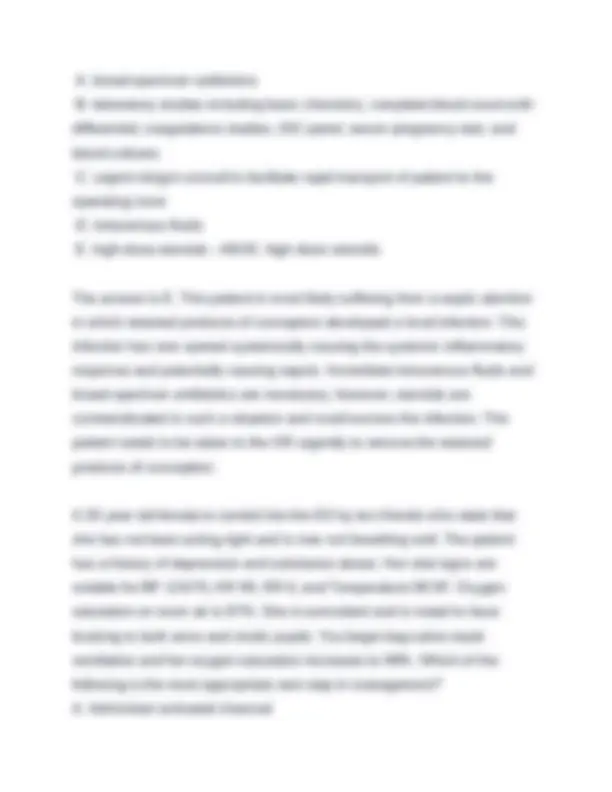
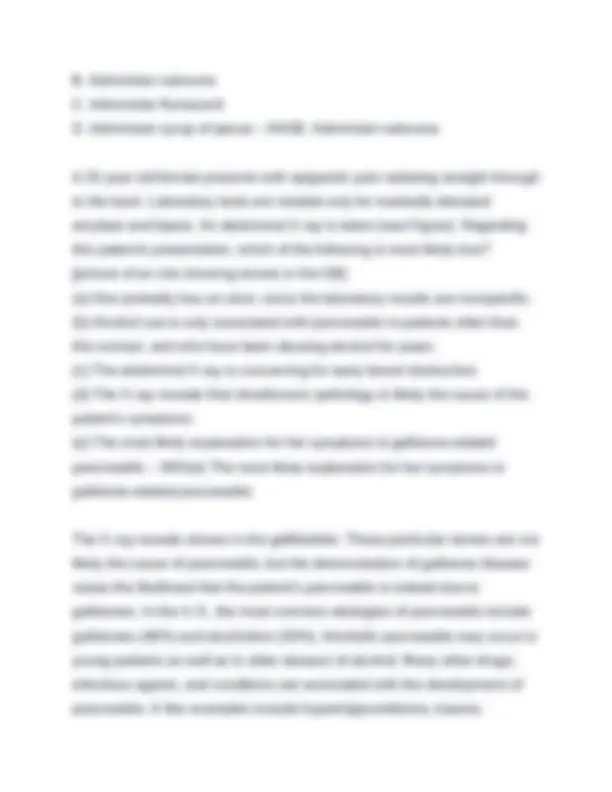
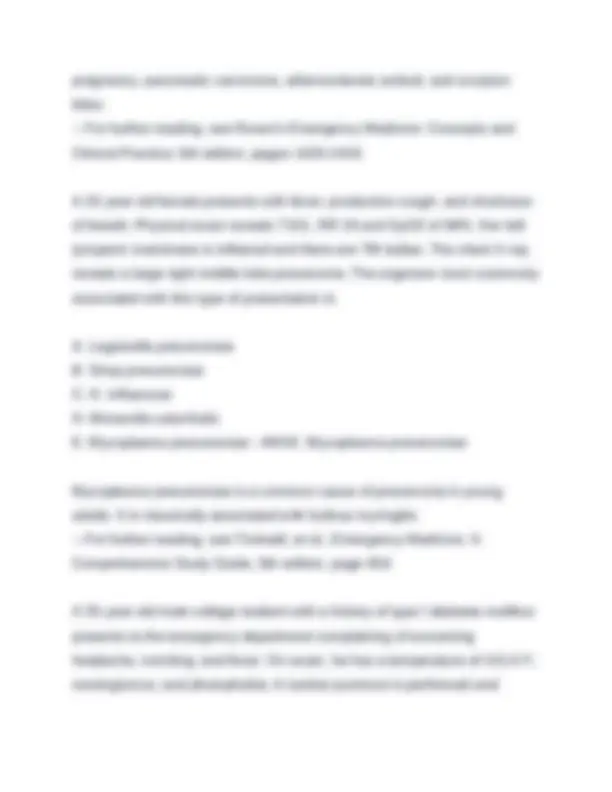
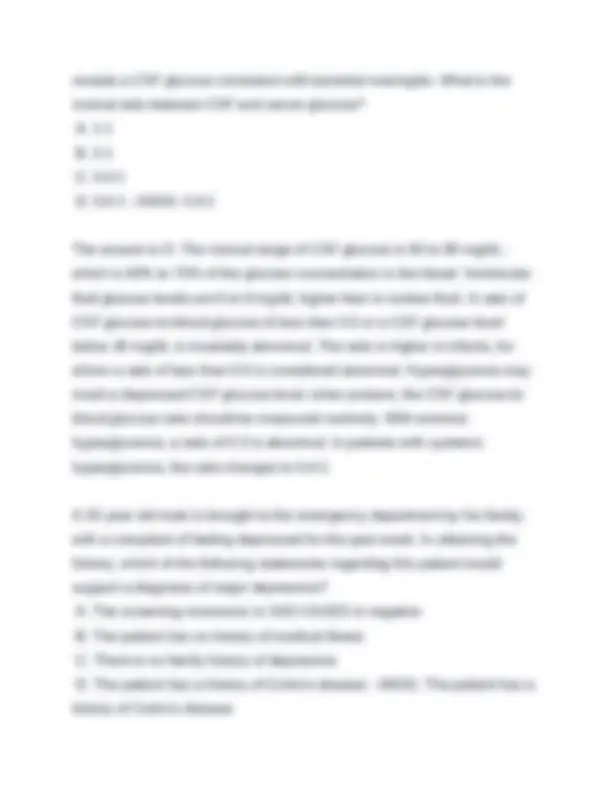
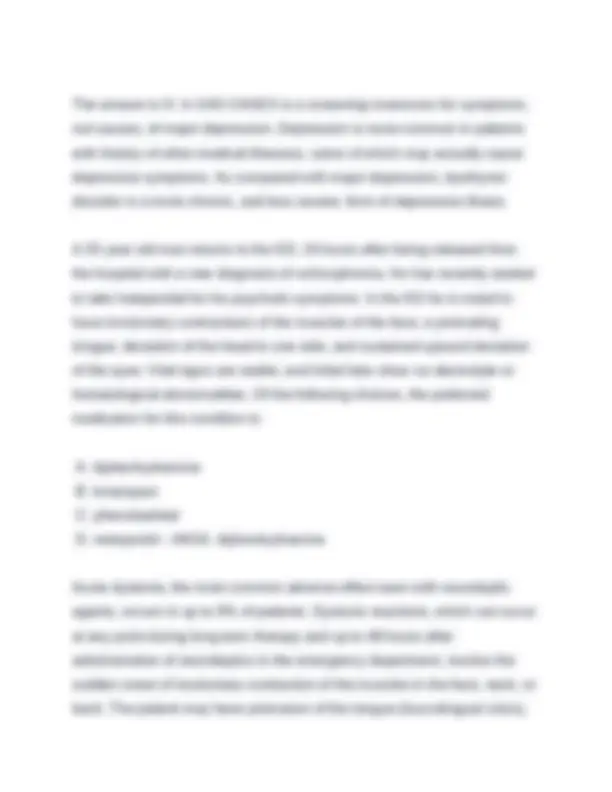
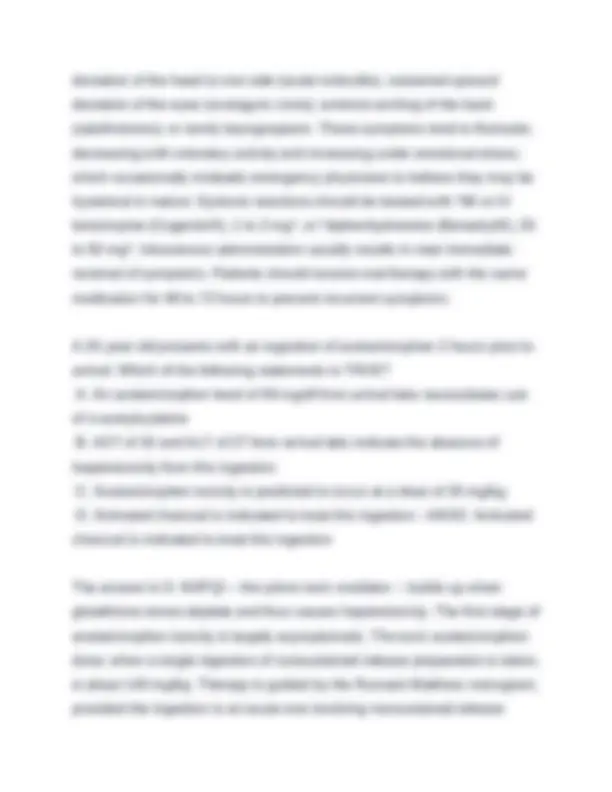
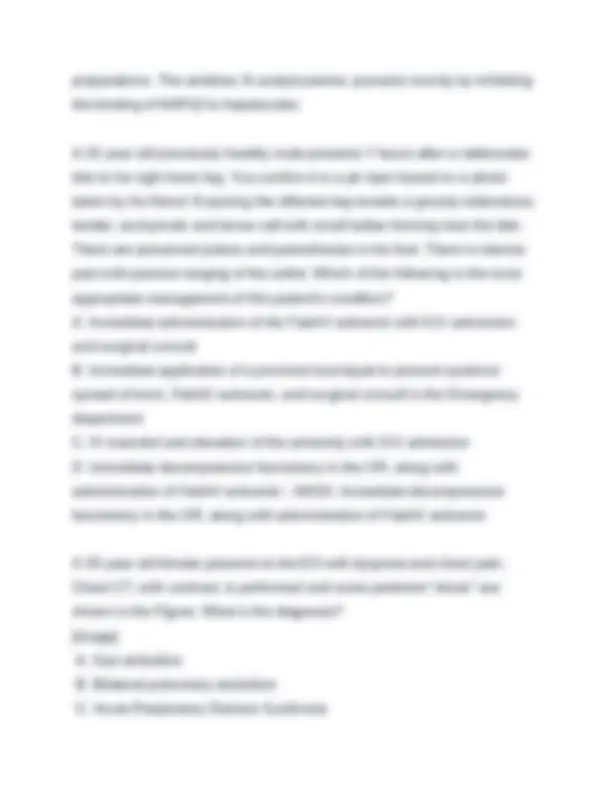
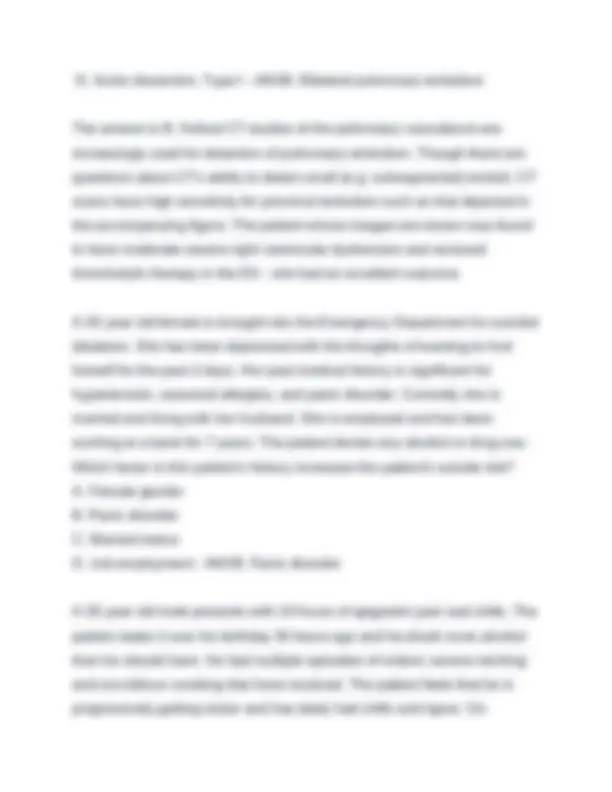
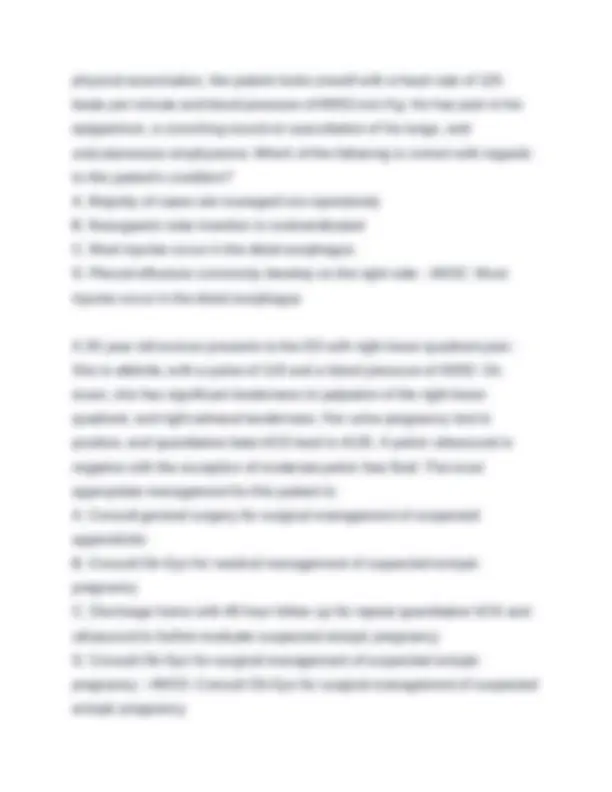
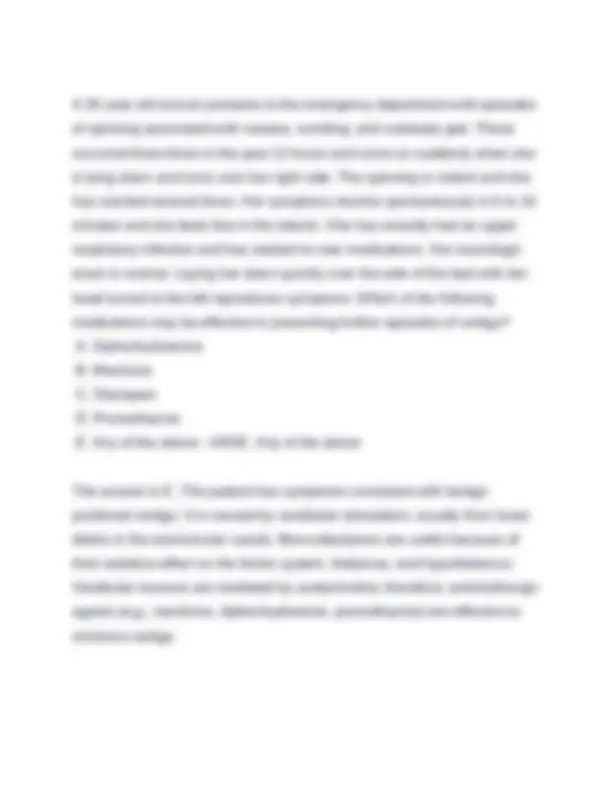
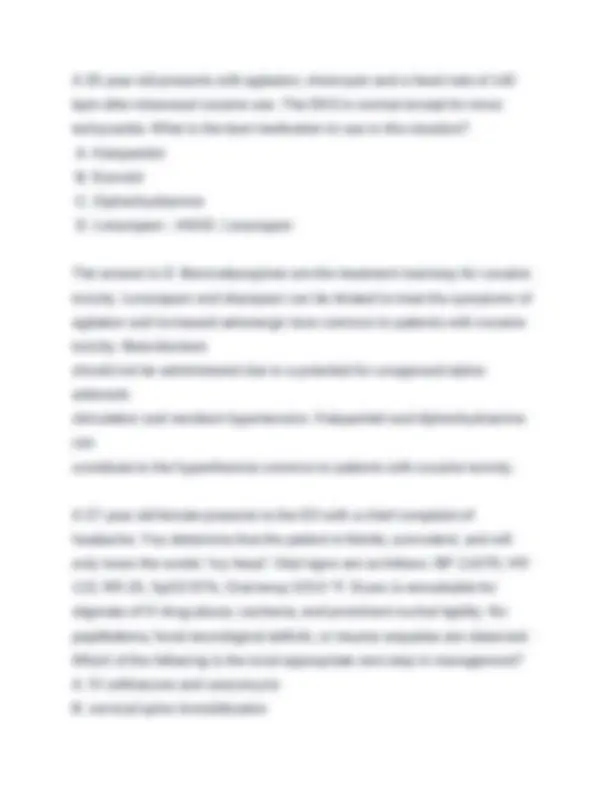
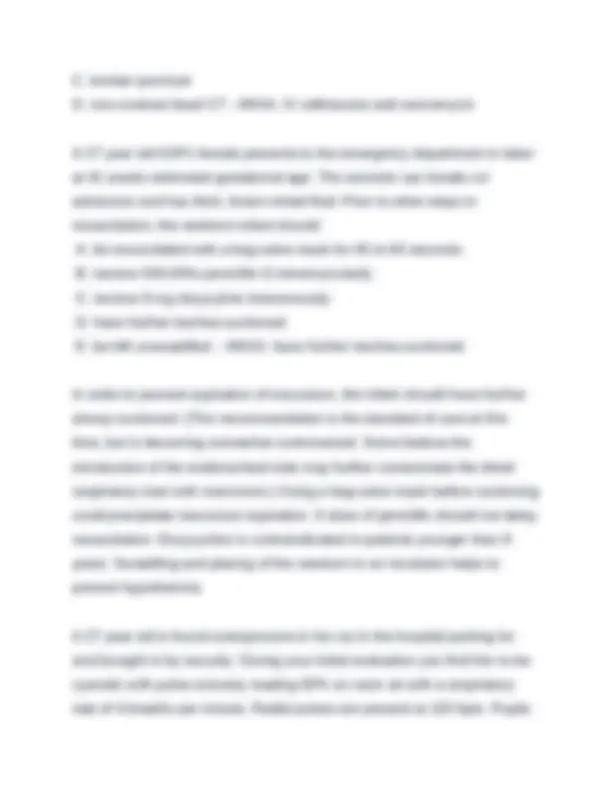
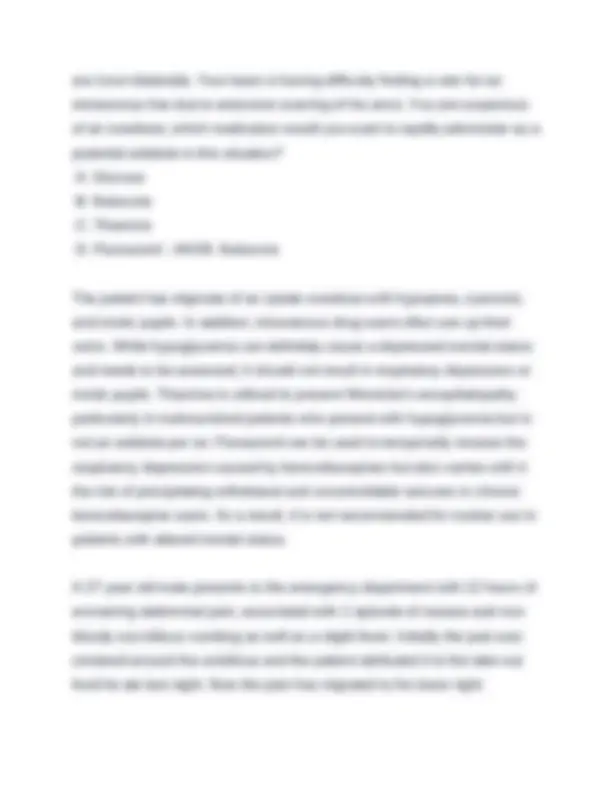
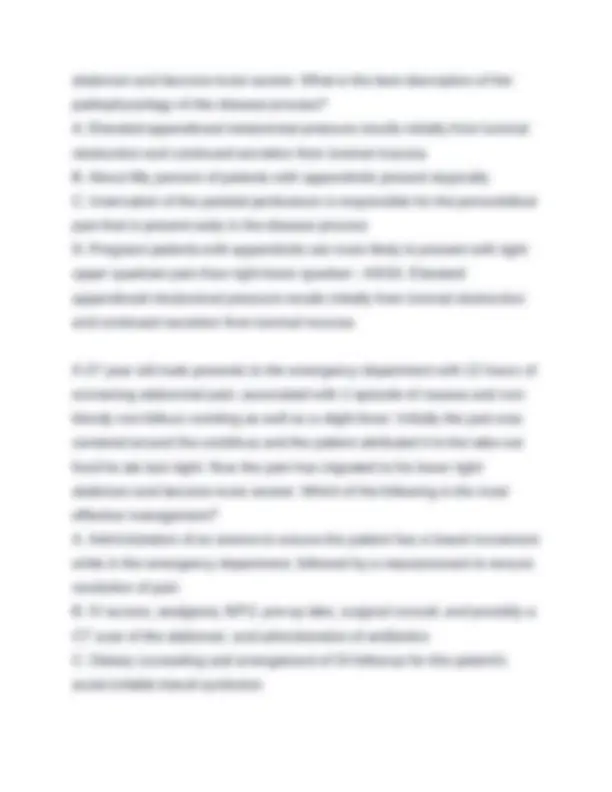
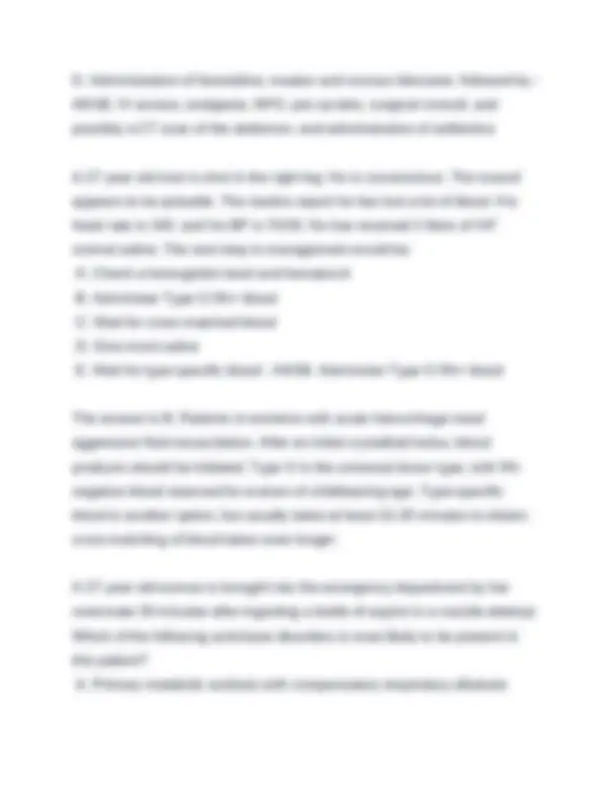
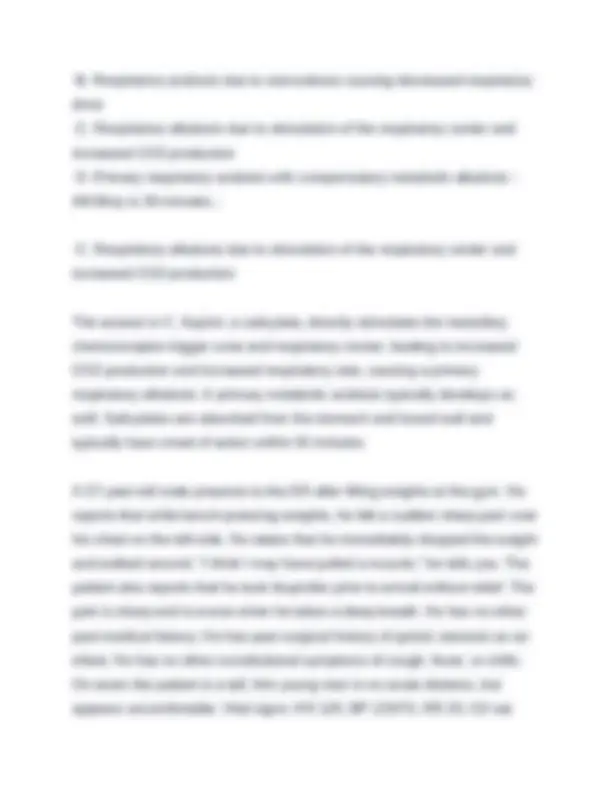
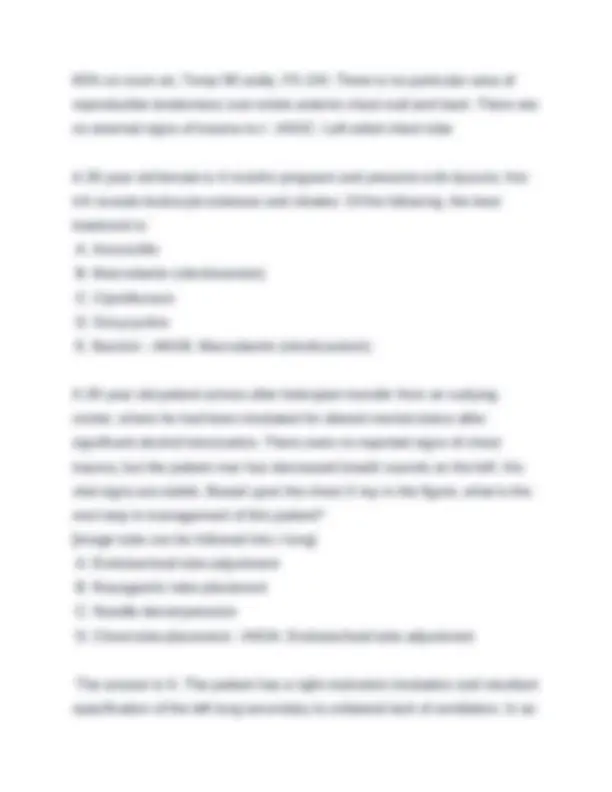
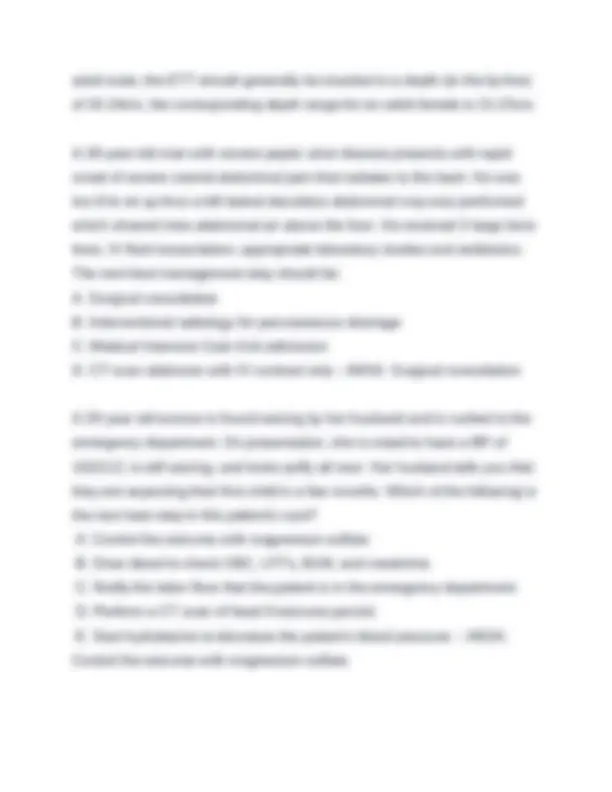
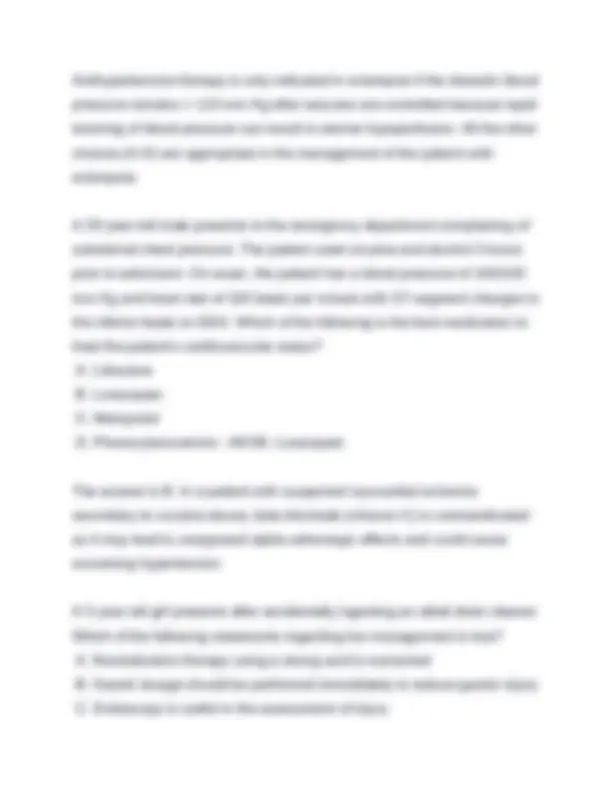
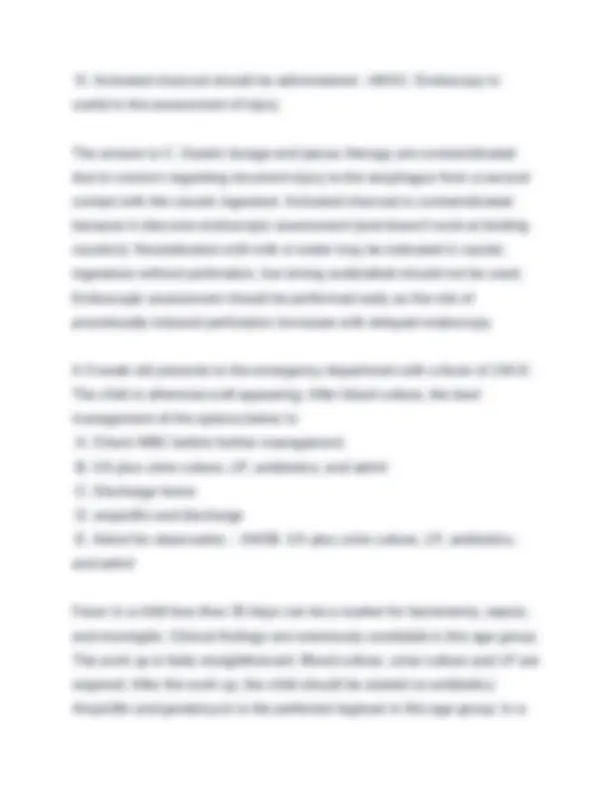
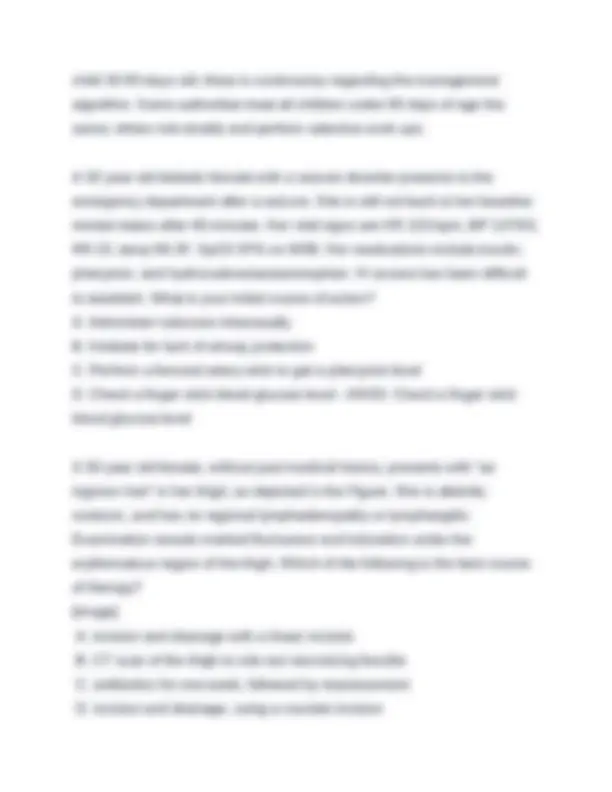
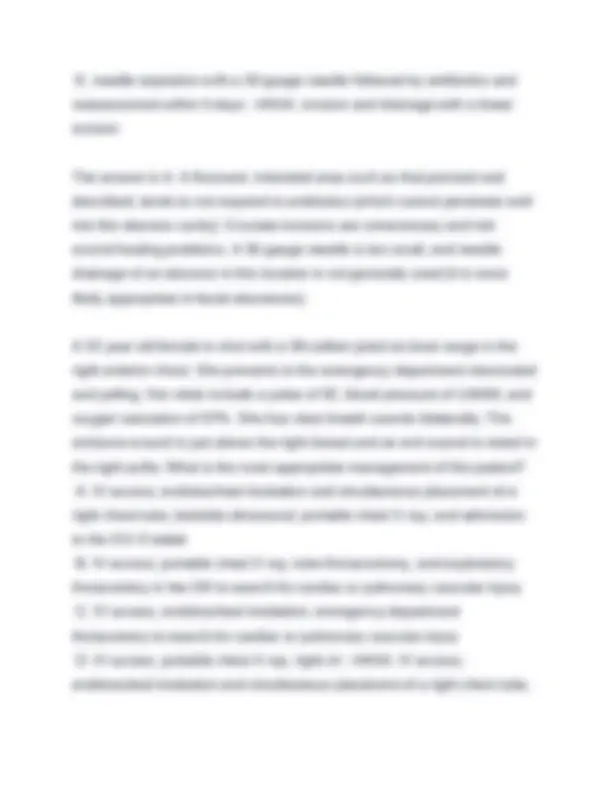
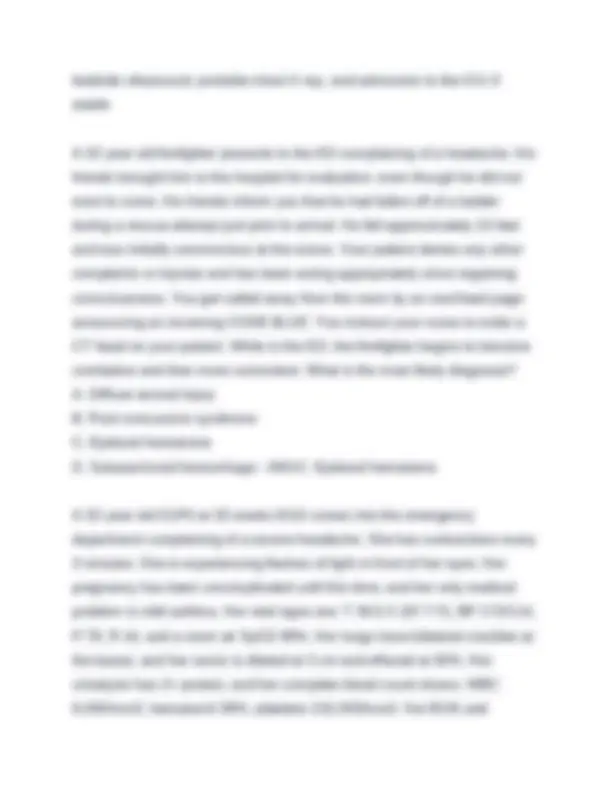
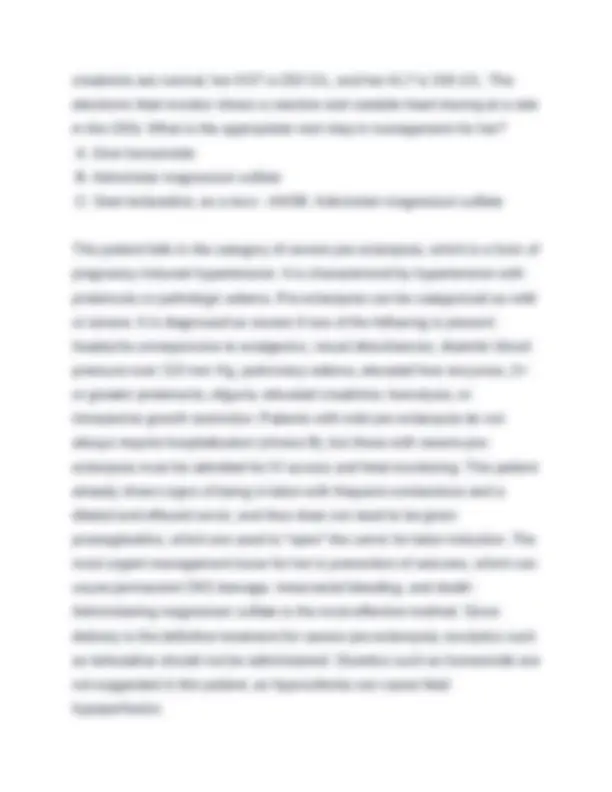
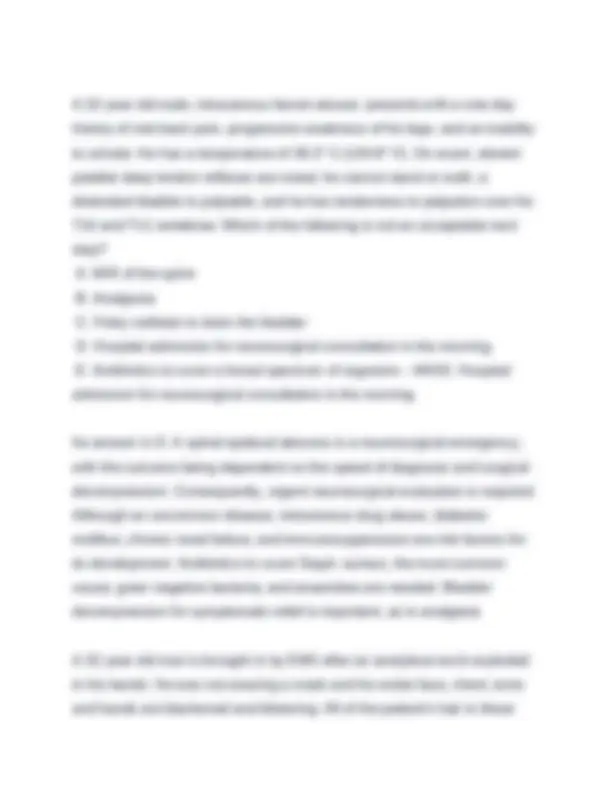
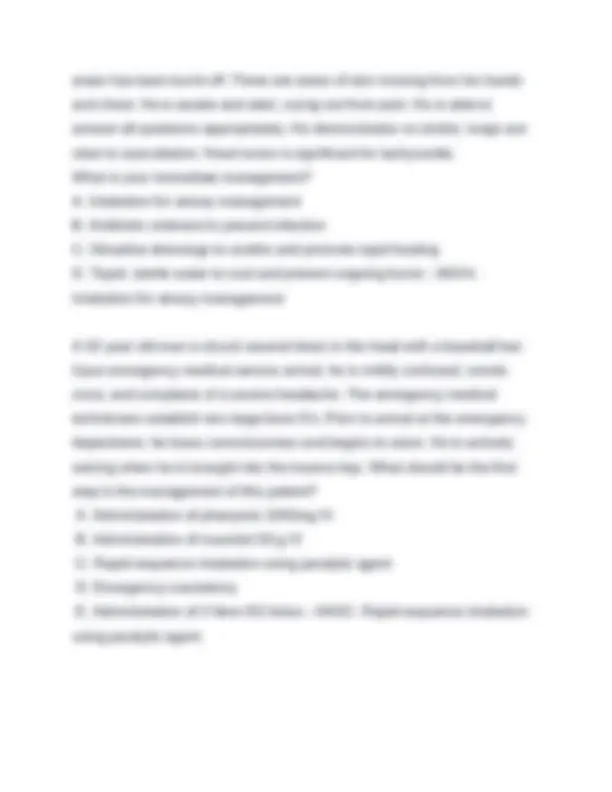
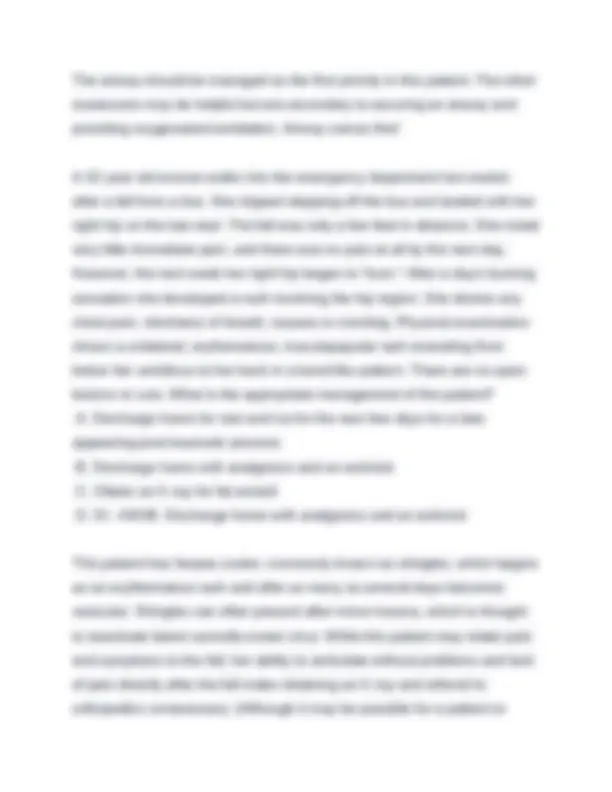
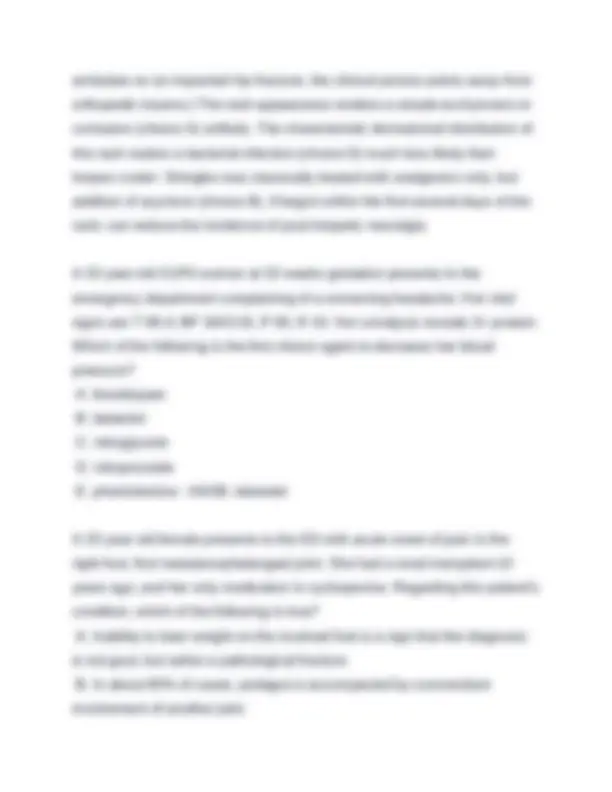
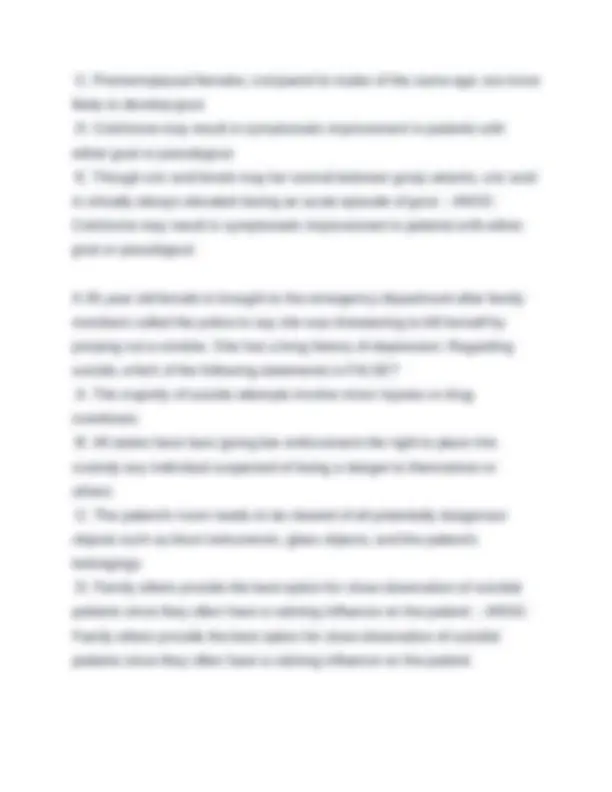
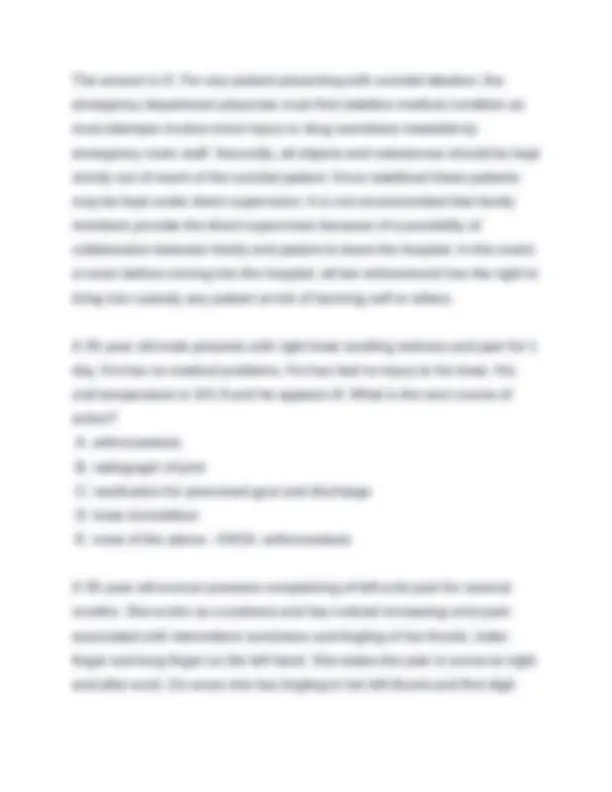
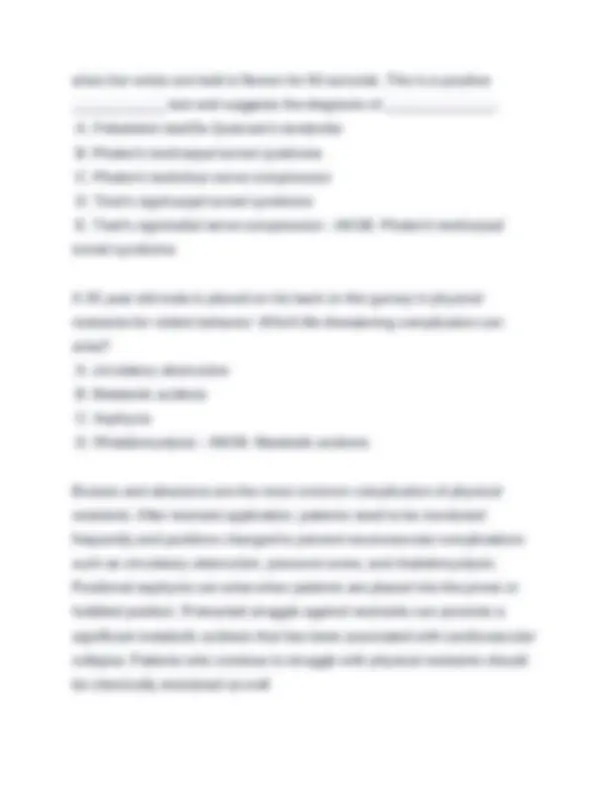
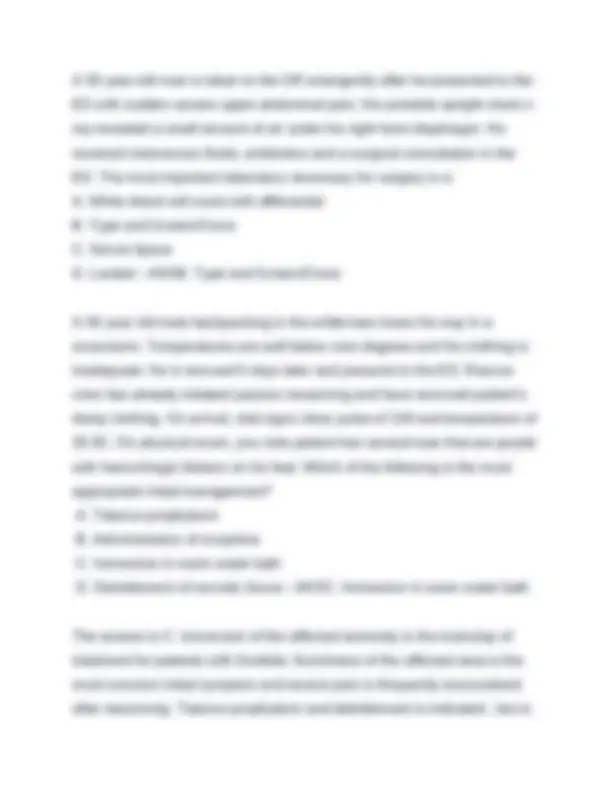
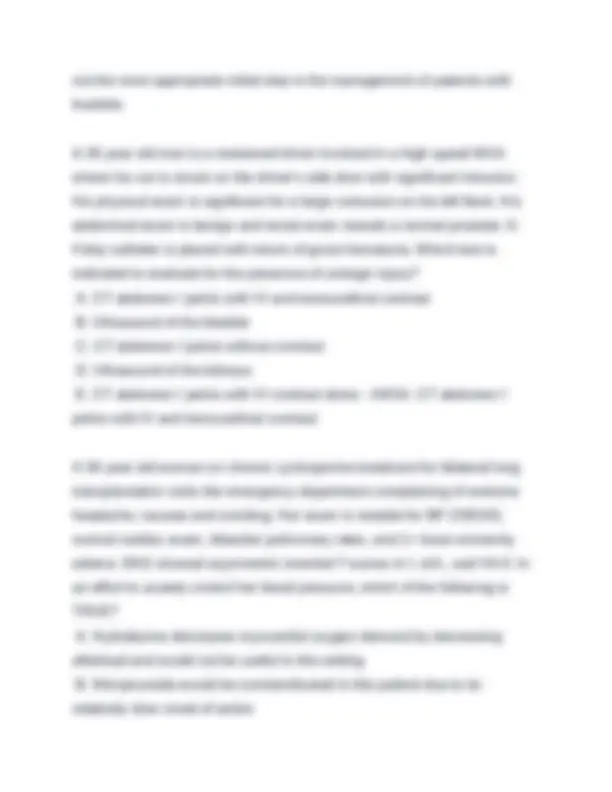
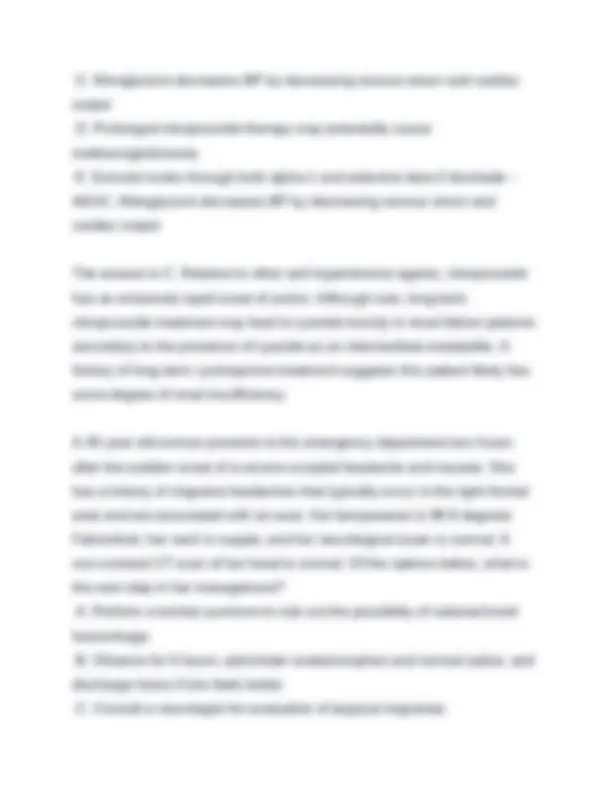
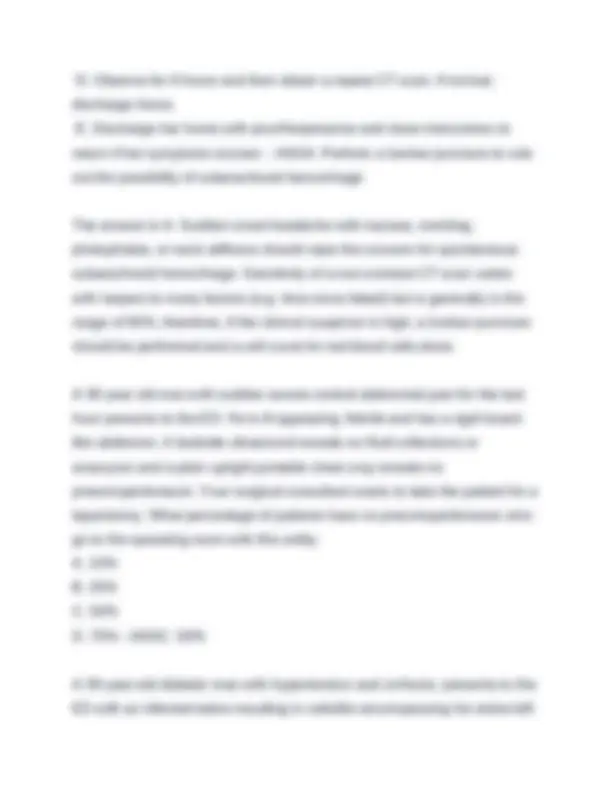
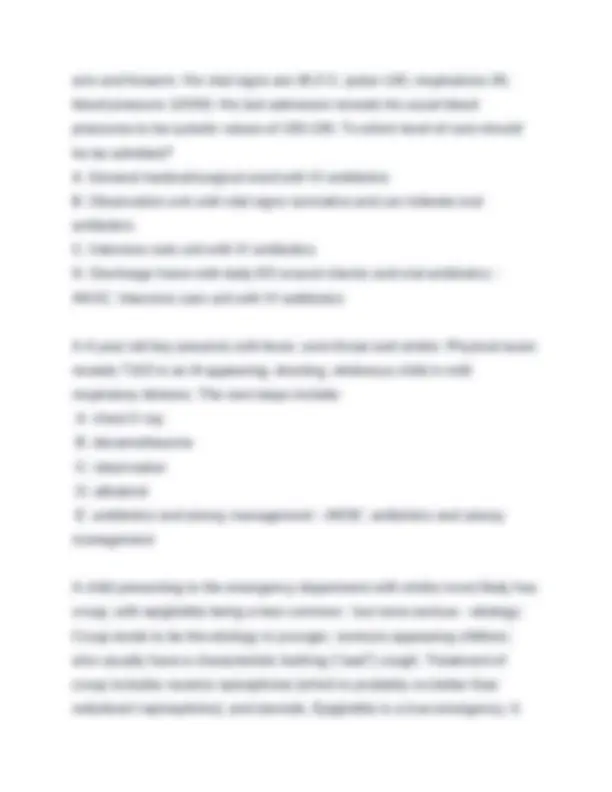
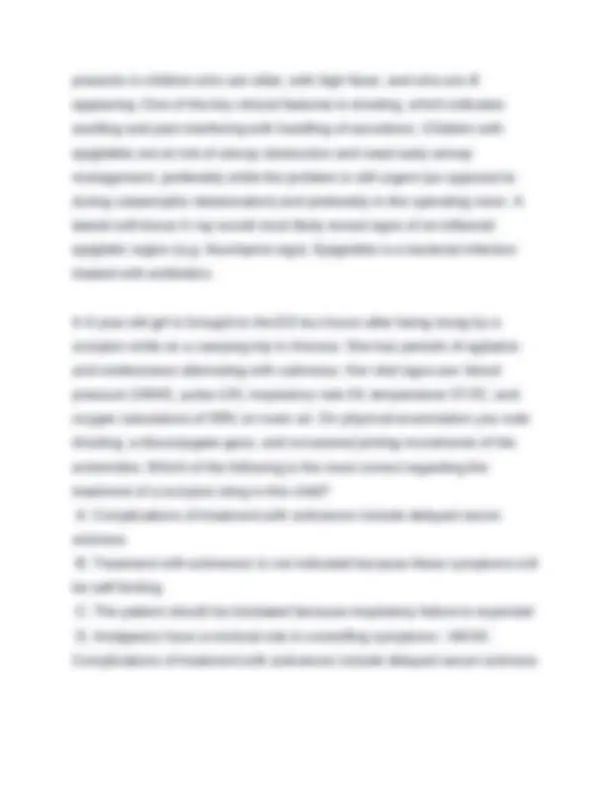
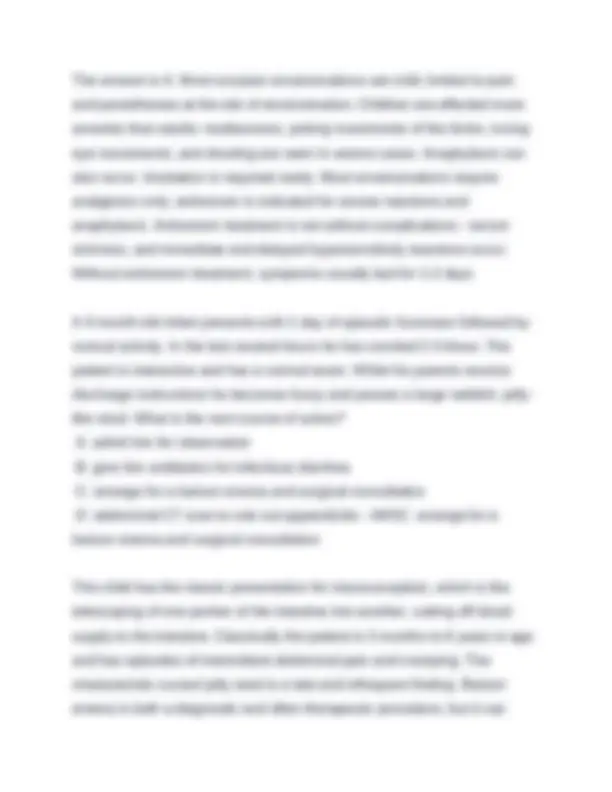
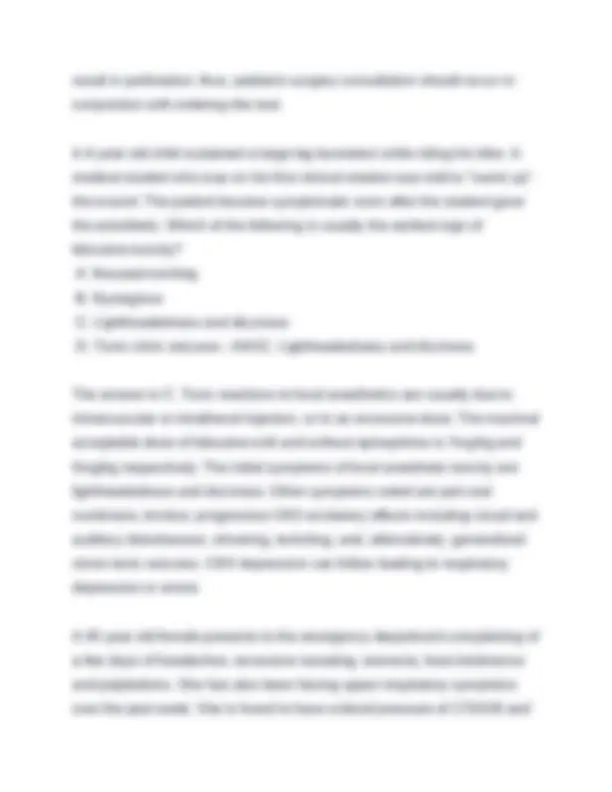
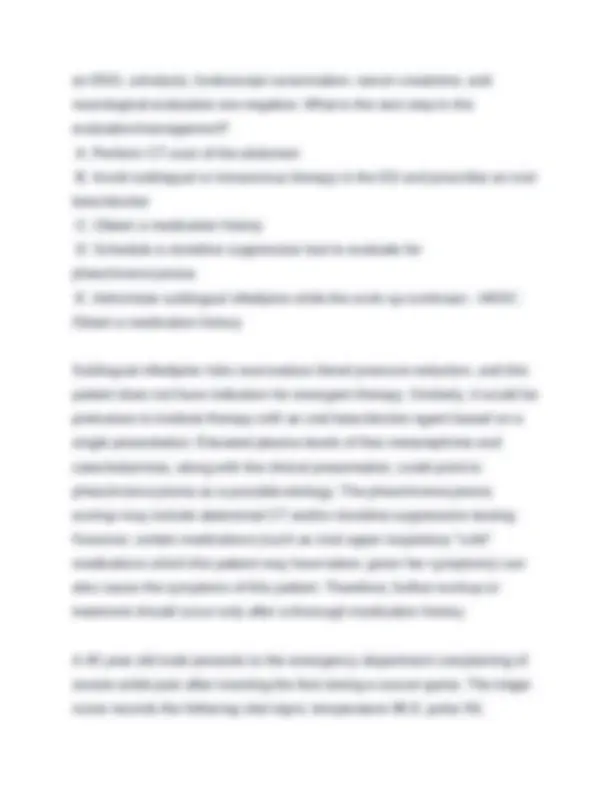
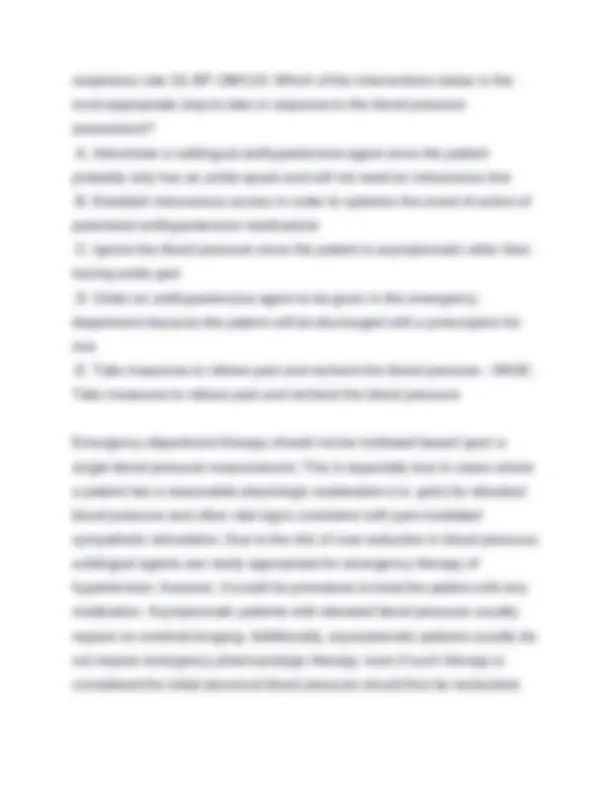
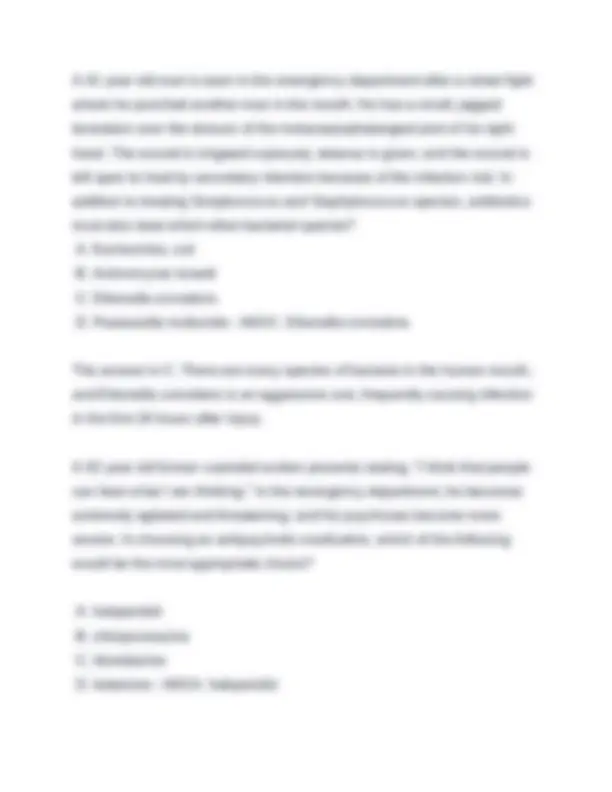
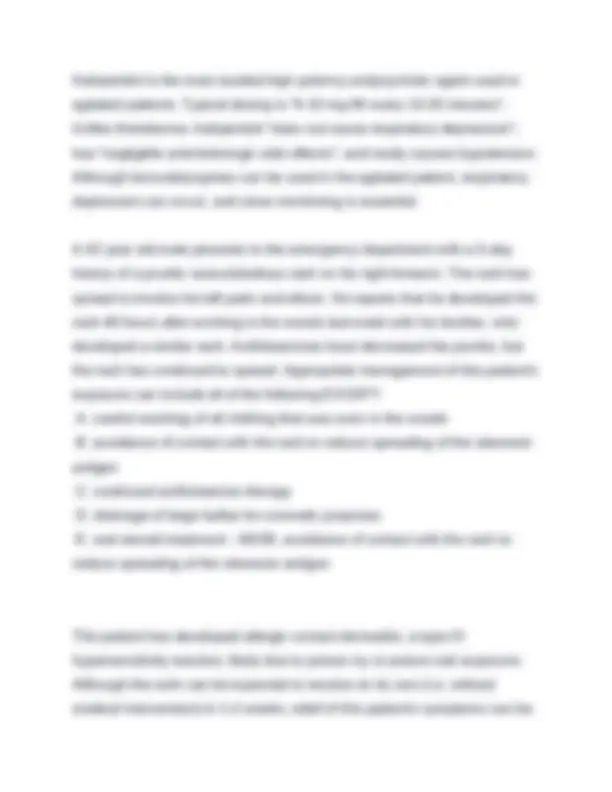
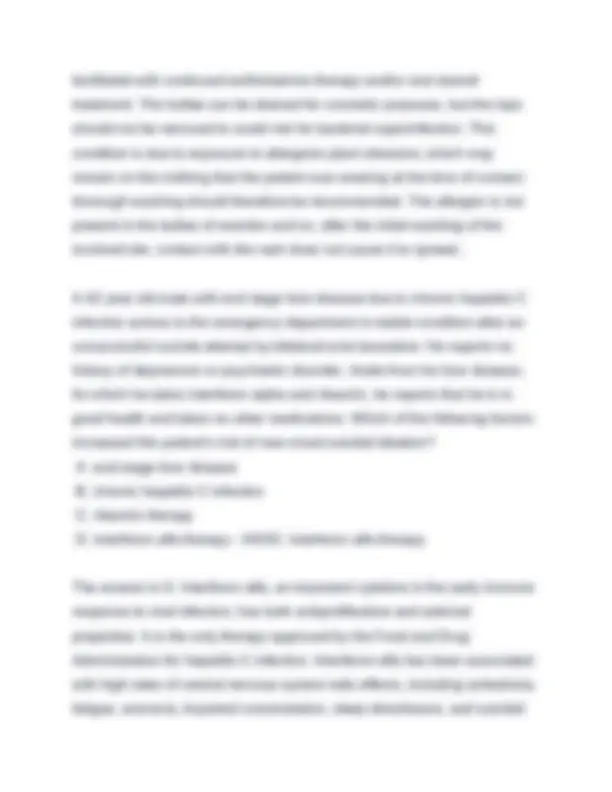
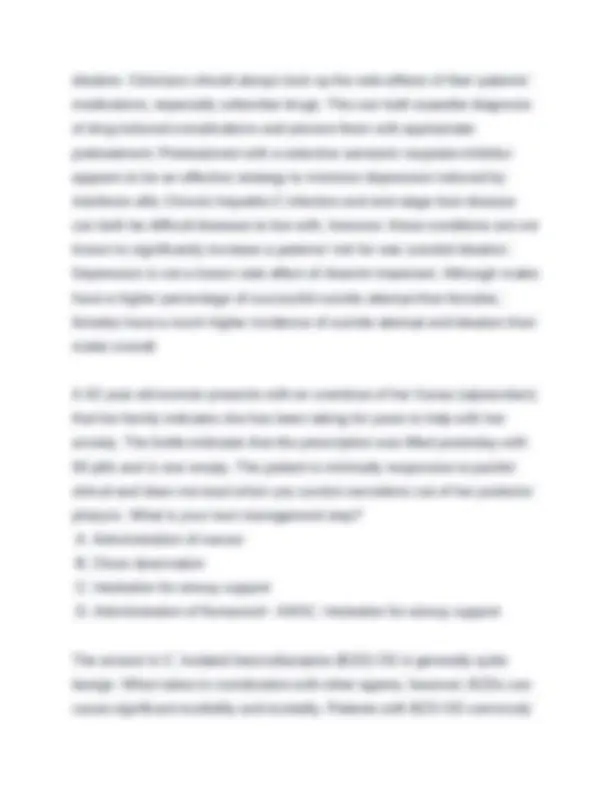
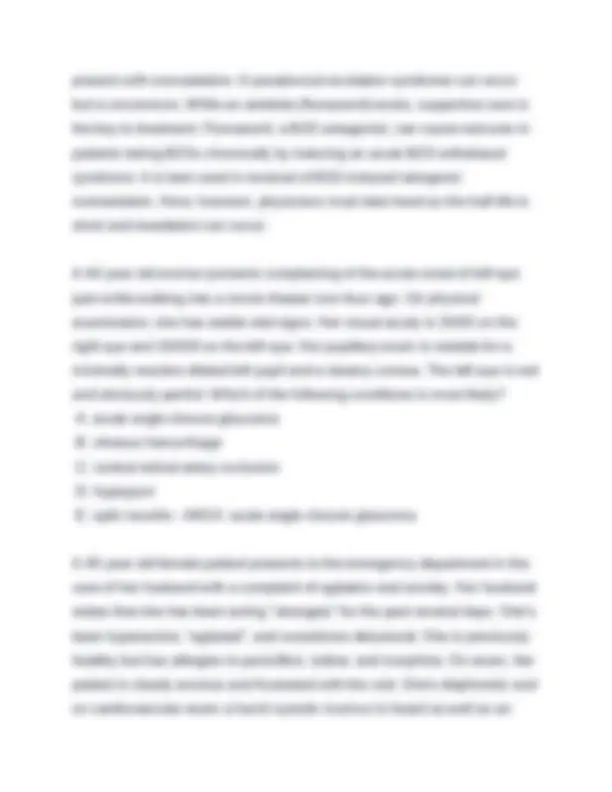

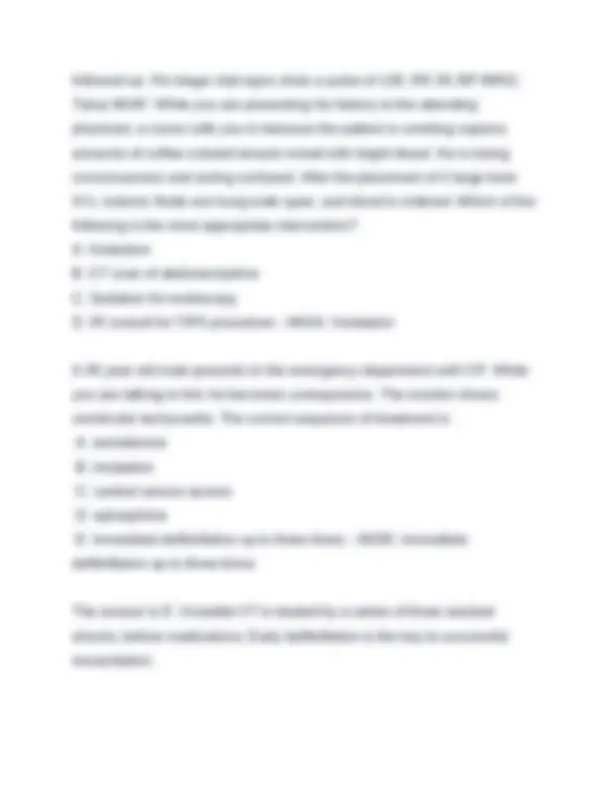
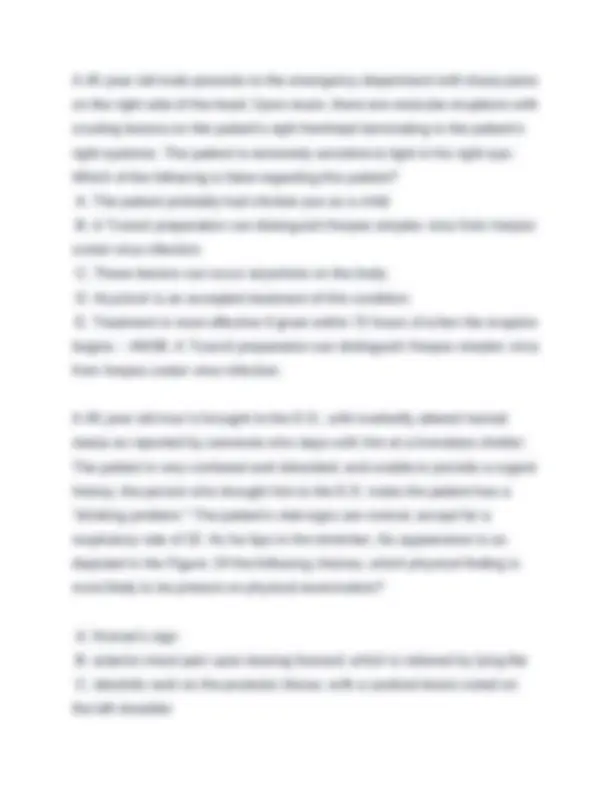
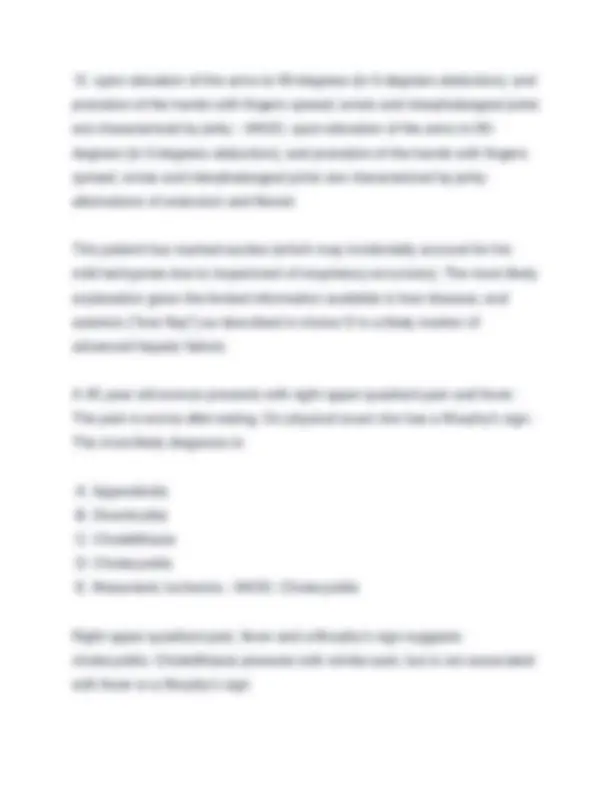
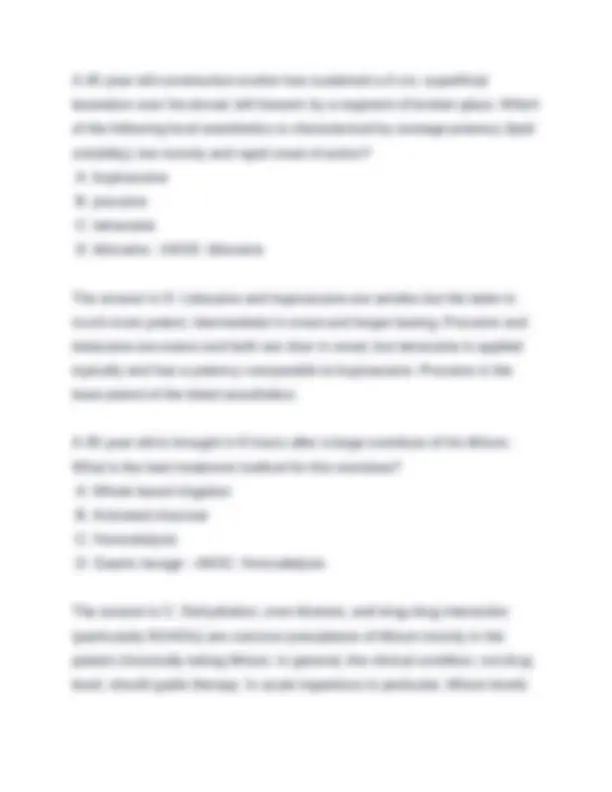
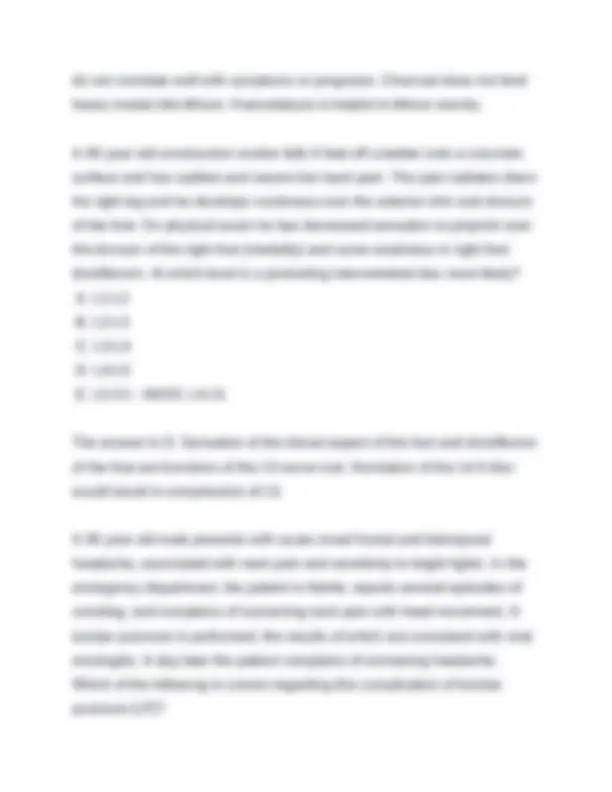
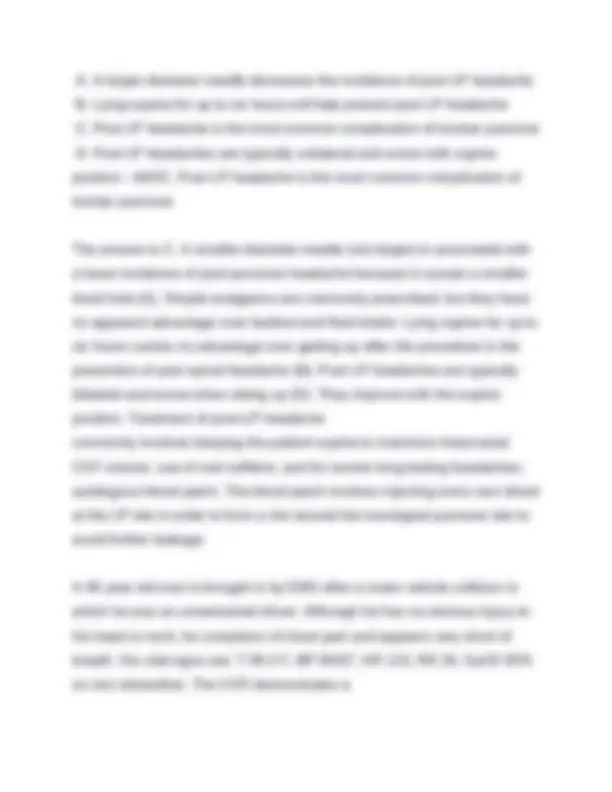
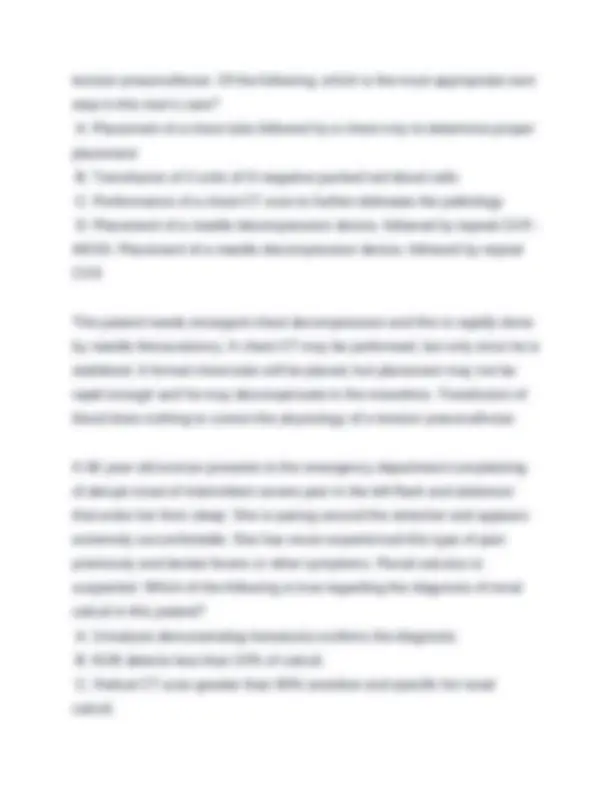
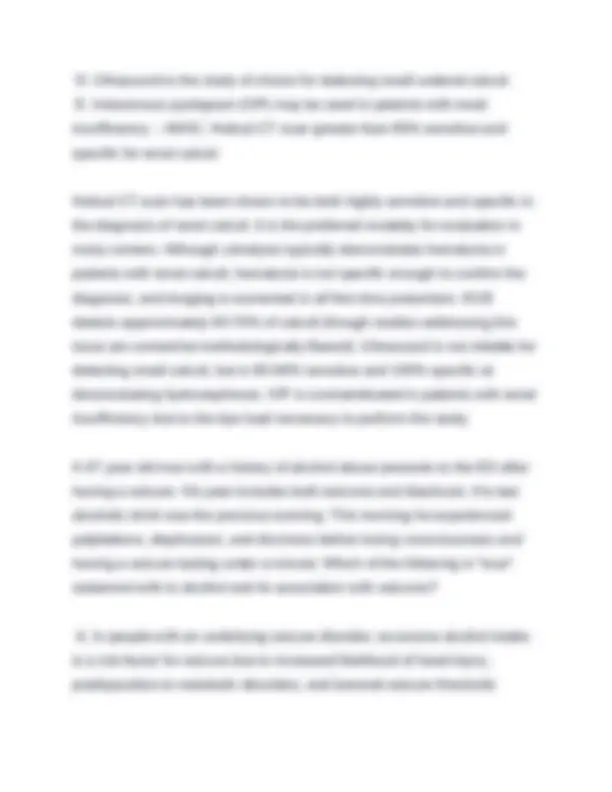
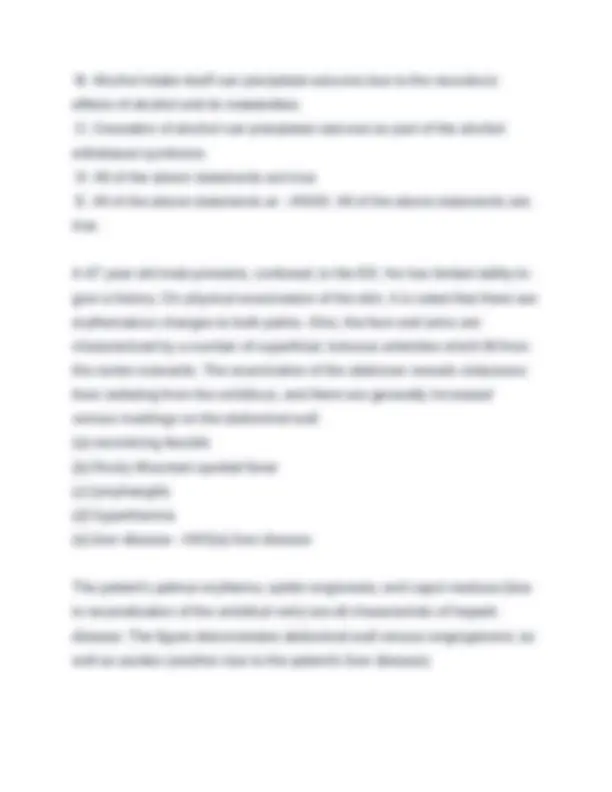
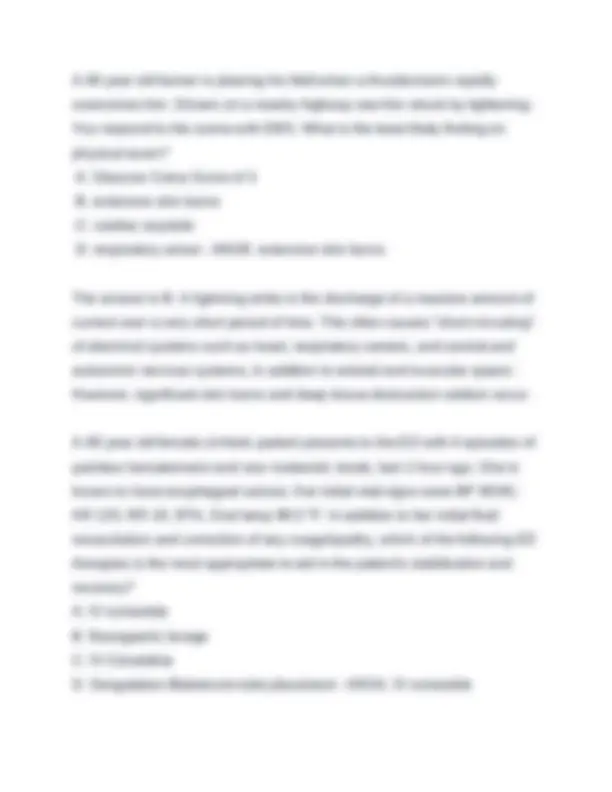
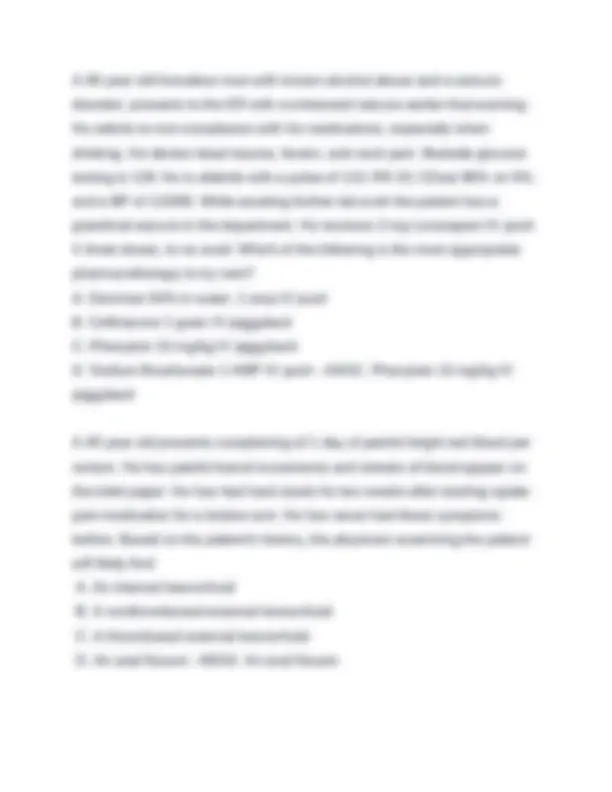
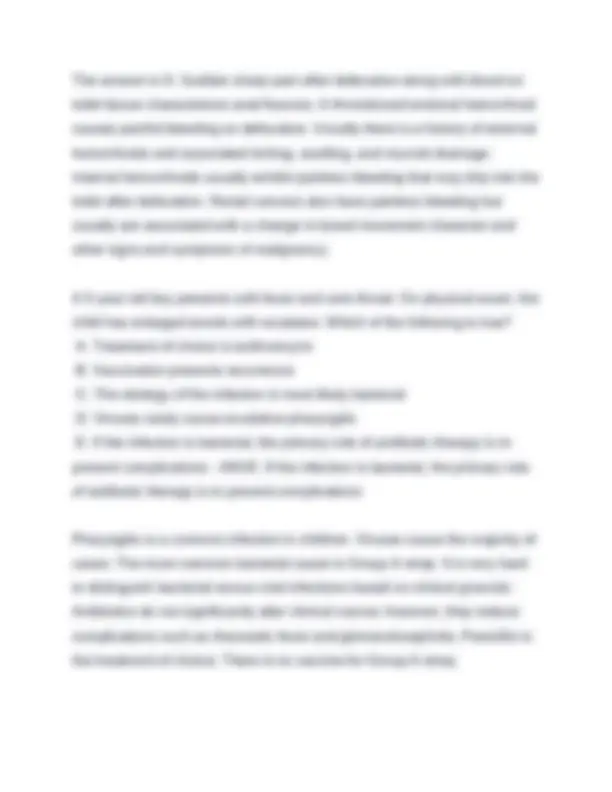
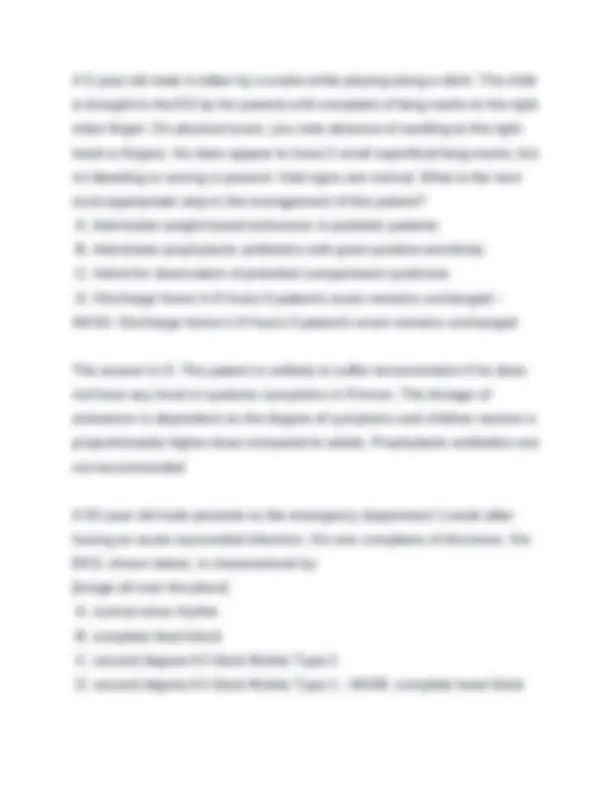
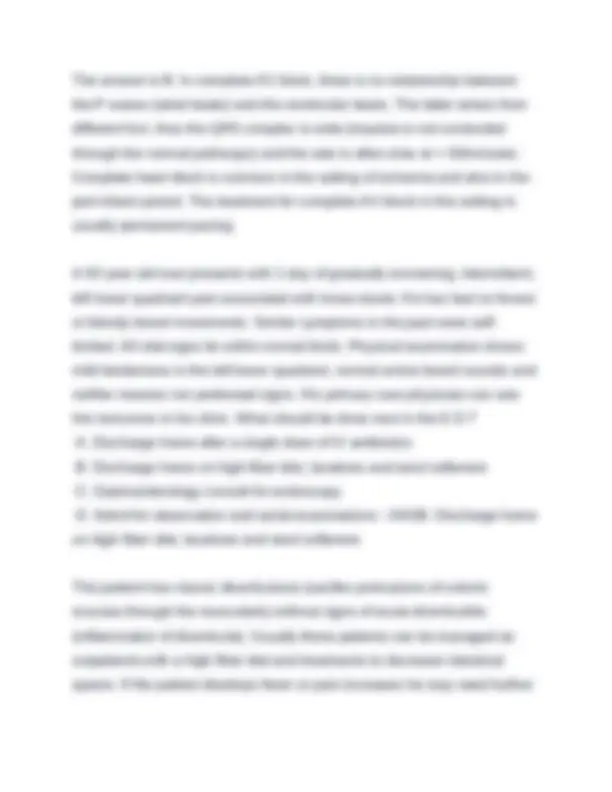
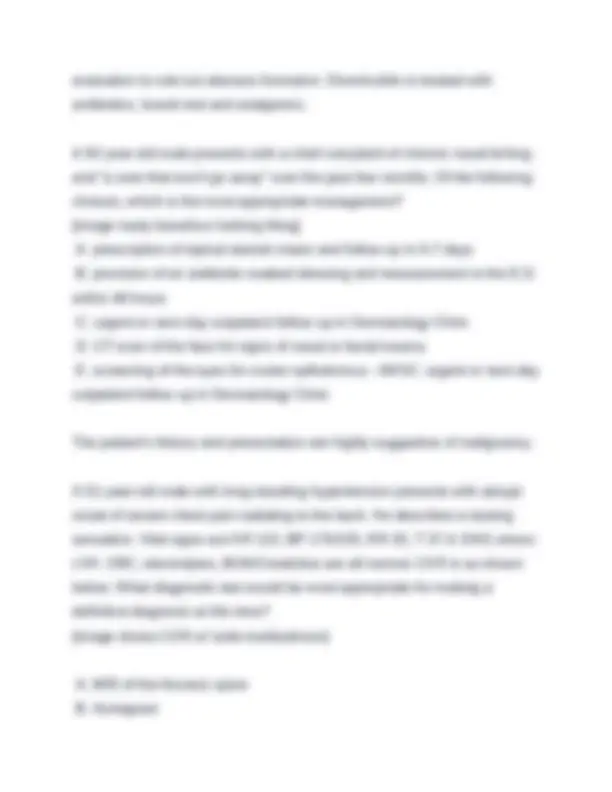
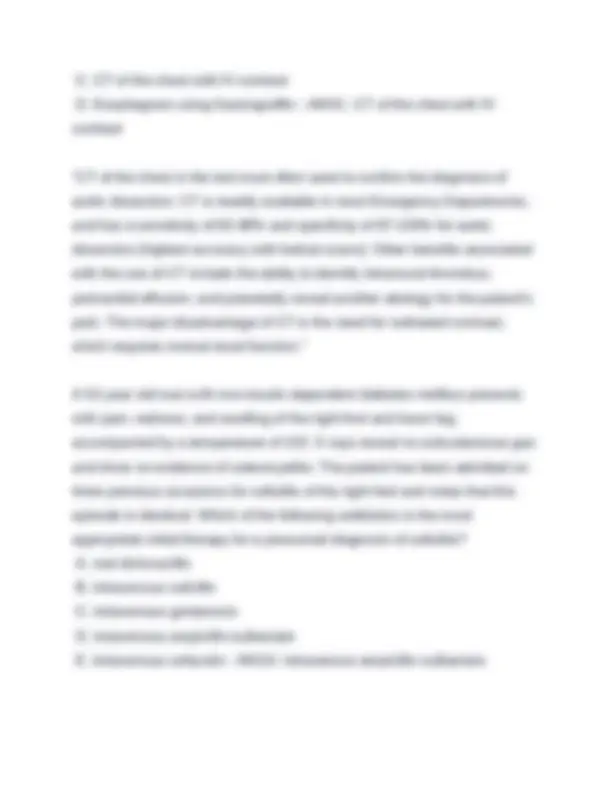
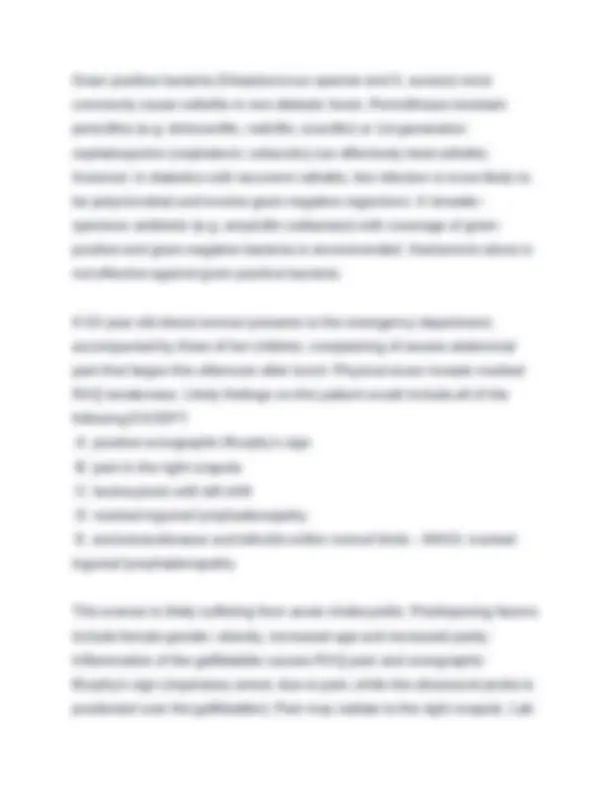
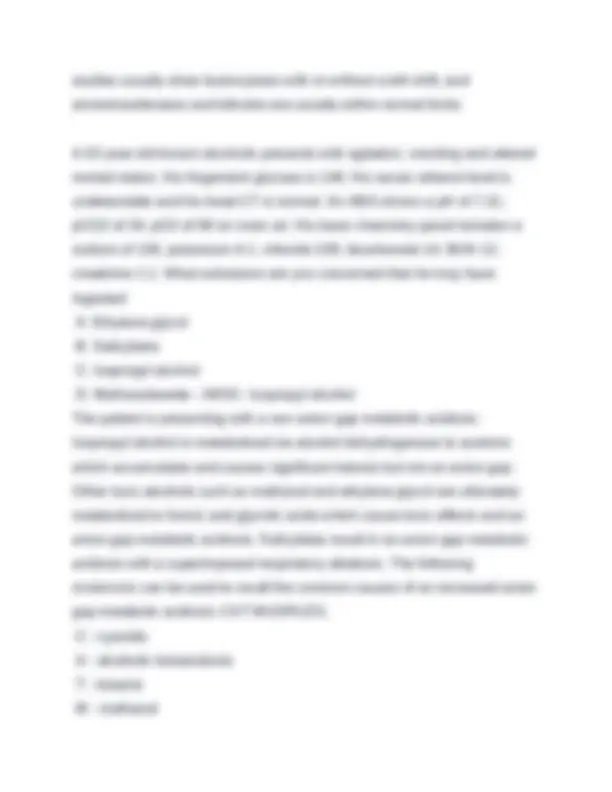


Study with the several resources on Docsity

Earn points by helping other students or get them with a premium plan


Prepare for your exams
Study with the several resources on Docsity

Earn points to download
Earn points by helping other students or get them with a premium plan
Community
Ask the community for help and clear up your study doubts
Discover the best universities in your country according to Docsity users
Free resources
Download our free guides on studying techniques, anxiety management strategies, and thesis advice from Docsity tutors
SAEM Practice Updated Version 2025-2026. Questions & Correct Verified Answers. Graded A
Typology: Exams
1 / 316

This page cannot be seen from the preview
Don't miss anything!





























































































"Silent Suicide" is defined as: A. an act of slowly killing oneself by nonviolent means, such as starvation or non-compliance with essential medical treatment B. an attempted suicide C. suicide involving a number of willing and sometimes not so willing participants D. a self-destructive act disguised as an accident E. recurrent self-destructive acts, such as heavy drinking in the presence of alcoholic liver disease - ANSA. an act of slowly killing oneself by nonviolent means, such as starvation or non-compliance with essential medical treatment The answer is A. "Silent Suicide" is most common in elderly patients and frequently goes unrecognized. Such patients may present to the emergency department repeatedly because of non-compliance with treatment of their medical disorders. "Occult Suicide" is applied to self- destructive acts disguised as accidents and should be suspected in those who have "accidental" self-inflicted gun shot wounds, and in those who "unintentionally" overdose, or who fall from a height. "Chronic Suicidal Behavior" consists of recurrent self-destructive acts. "Mass or Group Suicide" is suicide involving a number of people. "Parasuicide" is an attempted suicide, which is seen more as a gesture than a serious act.
19 year old man is brought in to the emergency department by EMS after being found obtunded in his apartment. No additional history is available. On arrival, the patient is minimally responsive with sonorous respirations and a palpable rapid pulse. The most appropriate initial diagnostic test would be A. Arterial blood gas B. Electrocardiogram C. Fingerstick glucose D. Urine drug screen - ANSC. Fingerstick glucose Hypoglycemia is a common and readily treatable cause for altered mental status. An ABG is unlikely to be diagnostic and more likely to reflect secondary abnormalities caused by respiratory depression. While a urine drug screen may show positives, it cannot quantitate the amount of a substance or the time period in which the exposure occurred so a positive screen may not reflect cause and effect. An EKG, while a part of a toxicology evaluation, is not an appropriate initiate screening test for an unstable patient until airway and readily reversible causes have been addressed. 56 year old male presents with sub-sternal chest pain for 4 hours with worsening shortness of breath for the last 2 hours. The patient's heart rate is 108 beats per minute, respiratory rate of 24 breaths per minute, and oxygenation saturation of 94% on room air. On physical examination, the patient appears dyspneic. On auscultation, he has a harsh II/VI systolic murmur with rales midway up bilateral lung fields. A bedside
C. The approach for subcuticular suture. D. The injection plane for local anesthesia infiltration. E. Use of a "finder needle" to mark suture entry points. - ANSB. The needle entry angle that optimizes eversion of sutured skin edges. The answer is B. Eversion of the skin edges is maximized by directing the needle entry as shown in the figure. Injection for local anesthesia should usually be performed through the wound, rather than through intact skin. Use of skin clamps can damage tissue; in cases where skin stabilization is needed gentle forceps application is preferred. Subcuticular sutures are placed deep to the skin. A "BLS" ambulance differs from an "ALS" ambulance in that the BLS ambulance: A. is stocked with different supplies and equipment B. operates under off-line, as opposed to on-line, medical control C. arrives at the patient first D. is staffed by one EMT crew member (and one driver) rather than two EMTs E. is a smaller "van"-type ambulance - ANSA. is stocked with different supplies and equipment A 10 year old boy presents with high fever and a rash. The rash started on his wrists and ankles and has spread to his trunk, palms, and soles. The correct diagnosis is most likely: A. varicella B. Rocky Mountain spotted fever
C. tinea D. Lyme disease E. scarlet fever - ANSB. Rocky Mountain spotted fever A 12-day-old term infant presents for evaluation of vomiting blood-streaked emesis once after feeding. She is well appearing and well hydrated with normal vital signs and an unremarkable exam. She is breast-fed. What should the physician do next? A. Start an H2 blocker for reflux. B. Start a workup for a bleeding diathesis. C. Begin a septic workup. D. Ask the mother if she has any bleeding from her nipples. - ANSD. Ask the mother if she has any bleeding from her nipples. A 14 year old presents just after smoking crack cocaine and complains of chest pain. He describes it as sharp and stabbing in the middle of his chest. His EKG is normal. The intern reads the CXR as "negative" but your supervising resident asks you to have another look (see Figure), after which you make the diagnosis of: [image: big round heart, black in mediastinum, widened] photo courtesy of eMedicine.com A. Pneumonia B. Aortic dissection C. Congestive heart failure D. Pneumomediastinum - ANSD. Pneumomediastinum
the nipple line. His vital signs are: T 97.9, HR 76, BP 80/40, RR 12, SPO 84%. He has no JVD and his lungs are clear. The patient's diagnosis is: A. Sepsis B. Hypovolemic shock C. Near drowning D. Neurogenic shock E. Spinal shock - ANSD. Neurogenic shock The answer is D. The patient is most likely suffering a spinal cord injury, producing a disruption of the autonomic nervous system leading to vasodilation and hypotension (without the expected tachycardic response). This entity, called neurogenic shock, is a type of distributive shock like anaphylactic shock It is important to rule out other internal injuries in this patient, and then institute therapy with a pressor agent such as phenylephrine. Spinal shock is not truly a shock state, but is paralysis and a sensory deficiency level w/ areflexia. A 16 year old male presents with a large swollen right knee. He denies any trauma. His physical exam reveals T101 and a swollen right knee. The knee is hot, and there is pain with motion. Also noted is a diffuse rash. The correct diagnosis is: A. Osgood-Schlatter B. Neisseria gonorrhea C. gout D. pseudogout E. juvenile rheumatoid arthritis - ANSB. Neisseria gonorrhea
A 17 year old boy injured his right shoulder playing football. He tried to arm- tackle a player when his right arm was pulled away from his body and back (abducted and extended). He felt a sudden pain in his shoulder. He presents to the emergency department holding his arm in slight abduction and external rotation by his good arm. He has severe pain with adduction or internal rotation. What is the most common fracture associated with this injury? A. Avulsion fracture of the greater tuberosity of the humerus B. Compression fracture of the posteriolateral aspect of the humeral head (Hill-Sachs deformity) C. Clavicle fracture D. Acromioclavicular joint separation E. Fracture of the anterior glenoid lip (Bankart's fracture) - ANSB. Compression fracture of the posteriolateral aspect of the humeral head (Hill-Sachs deformity) A 17 year old male presents to the emergency department complaining of excruciating groin pain that woke him from sleep. This pain is associated with nausea and radiation into the abdomen. On examination his right testicle is firm, exquisitely tender, and there is unilateral absence of the cremasteric reflex. A bedside diagnostic and therapeutic maneuver would be to: A. Elevate the left testicle B. Rotate his right testicle in a medial to lateral rotation (540 degrees) C. Perform a bedside scrotal ultrasound D. Transilluminate the right testicle - ANSB. Rotate his right testicle in a medial to lateral rotation (540 degrees)
D. ceftriaxone IV E. azithromycin IV - ANSD. ceftriaxone IV The answer is D. In patients with meningitis, early antibiotics administration is of the utmost importance. Antibiotic administration should not be delayed to await diagnostic work up. Ceftriaxone, administered in some regions with vancomycin depending on the resistance profile of likely etiologic agents, is generally considered an antibiotic of choice in meningitis. Azithromycin and levofloxacin do not have good CNS penetration and therefore are not indicated for meningitis. A 19 year old male presents to the emergency department with allergic- mediated pruritis over large portions of his body. Which of the following is true regarding this condition? A. H2 antagonists such as ranitidine or famotidine have never been shown to provide benefit. B. Topical antihistamine agents should be encouraged to manage the pruritis. C. There is no role for therapies such as Domeboro solution (1:10 diluted aluminum sulfate soaks), potassium permanganate baths, and oat-meal baths. D. Oral doses of antihistamines should be encouraged initially. E. Second generation antihistamines such astemizole, fexofenadine, and loratadine are more effective but cause increased levels of sedation and should be avoided if possible. - ANSD. Oral doses of antihistamines should be encouraged initially.
The answer is D. Oral administration of diphenhydramine or hydroxyzine (25 to 50 mg po q6H) is an appropriate adult dose and is effective for pruritis. Intravenous administration can also be used. Topical antihistamines are quickly absorbed, making it difficult to predict the actual dosing if a patient aggressively applies the preparation. Thus, use over large areas of the body should be avoided especially if the patient is currently taking oral antihistamine. The bath or soaking therapies are also recommended to control large areas of pruritis. Second generation antihistamines, although more costly, have lower dosing frequency requirements and cause less sedation. A 19 year old man is stabbed in the left chest in the 3rd intercostals space just to the left of the sternum. His vital signs are: T 97.9, HR 130, BP 60/48, RR 18, SPO2 84%. He has significant JVD and his lungs are clear. The patient's diagnosis is: A. Tension pneumothorax B. Lung laceration C. Spinal cord injury D. Hypovolemic shock E. Cardiac tamponade - ANSE. Cardiac tamponade The answer is E. The patient has a stab wound to the left chest near the sternum. His hypotension, clear lungs, and JVD suggest an obstructive shock. He likely has cardiac tamponade and needs emergent decompression either with pericardiocentesis or pericardial window.
A 19 year old woman is brought to the emergency department by her friends because she has been saying that she is a superhero and trying to run into traffic to prove that she is indestructible. The friends report that she has been using drugs but they do not know which ones. Which of the following pairs of ocular finding and recreational drug is commonly observed? A. dilated pupils - heroin B. internuclear ophthalmoplegia - marijuana C. pinpoint pupils - amphetamines D. vertical nystagmus - phencyclidine - ANSD. vertical nystagmus - phencyclidine Sympathomimetics (cocaine, amphetamines) cause dilated pupils. Opiates (heroin) cause pinpoint pupils. Internuclear ophthalmoplegia is associated with multiple sclerosis. CN VI palsy is not associated with any specific drugs. A 19-year-old G1P0 female, at 38 weeks EGA, presents to the emergency department complaining of headache, blurry vision and leg swelling. The physical examination reveals BP of 150/100, facial and hand edema, and hyperreflexia. Fetal heart monitoring demonstrates a reassuring pattern with no uterine contractions. Urine dipstick reveals 2+ proteinuria. Of the following, which factor is the most critical in formulating an ultimate management plan for this patient? A. Extent of maternal edema B. Fetal age C. Presence of variable decelerations on nonstress testing
D. Symptom duration - ANSB. Fetal Age The cure for pre-eclampsia is delivery of the baby, and the fetal age and maturity are the most important factors to consider in determining the planning for delivery. For pregnant women at or near term, induction of labor is usually indicated. A 2 and a half year old girl is brought in to the emergency department by her mother for "loud breathing" and a fever. The mother states the child has been previously healthy and is up to date on all her vaccines. Initial evaluation of the child reveals an ill-appearing child with her head propped upright, who is drooling and making stridorous noises. Her vital signs are notable for a temperature of 104.2 F. Which of the following is most likely in this child? A. Chlamydia pneumonia B. choanal atresia C. viral upper respiratory tract infection D. Stapholococcus aureus retropharyngeal abscess E. viral croup - ANSD. Stapholococcus aureus retropharyngeal abscess This patient exhibits several classic symptoms of retropharyngeal abscess including fever, neck stiffness, and drooling, as well as her generally toxic appearance. Retropharyngeal abscess in children is often associated with foreign body ingestion leading to perforation of the hypopharynx or esophagus. Pneumonia, viral croup and upper respiratory tract infection are unlikely to cause airway obstruction, which is suggested by this patient's drooling. Choanal atresia is typically diagnosed in infancy. Another
D. Objects lodged in the proximal airway have the worst prognosis - ANSD. Objects lodged in the proximal airway have the worst prognosis Large objects in upper airway and trachea have the worst prognosis and typically present with the most severe symptoms. A 2 year old male is brought to the ED in status epilepticus. He has not responded to adequate doses of benzodiazepines. Which of the following possible causes of a seizure must be evaluated for in the emergency department? A. Hypoxia B. Hypoglycemia C. Toxic ingestion D. Head trauma E. All of the above possible causes must be evaluated for - ANSE. All of the above possible causes must be evaluated for The answer is E. Seizures have a number of secondary causes, which must be identified and corrected before the seizure will end. Hypoxemia and hypoglycemia are easily detected by pulse oximetry and bedside measurement of glucose, respectively. Toddlers may ingest many toxins accidentally, such as INH, tricyclic antidepressants, and camphor. Trauma must be considered, too, including child abuse. Sickle cell disease, SLE, and leukemia are some of the medical causes of seizures and status epilepticus.
A 20 year old college female recently returned from spring break after hiking in the Virginia woods approximately two weeks prior to her presentation to the E.D. One day prior to presentation, she developed fever, chills, and anorexia. In the emergency department, she complains of headache, photophobia, and myalgias. On exam, one notices a disseminated, non-blanching, papular rash. Which of the following statements regarding this condition is FALSE? A. It is caused by the tick borne parasite Rickettsia rickettsii. B. 95% of patients develop symptoms between the period of April 1 and September 30. C. Characteristically the rash begins on the trunk and spreads to the extremities. D. A skin biopsy shows a necrotizing vasculitis. E. If untreated, fatality rates range between 25-50%; however, treatment reduces the rate to 10%. - ANSC. Characteristically the rash begins on the trunk and spreads to the extremities. The answer is C. Rocky Mountain Spotted Fever characteristically begins on wrist, forearms, and ankles. Within 6-18 hours, the rash spreads centripetally to the arms, thighs, trunk, and face. A 20 year old college student is brought to the emergency department by campus police after he was found by his roommate saying people in the TV were trying to kill him. Which of the following criteria is not an indication for admission? A. first-time psychiatric episode B. demonstrates risk for suicide
the age of 6. A stool culture should be obtained to rule out bacterial colitis, but his history is less suggestive of this. A 20 year old man used his left hand to punch another person in a bar fight. The man complains of pain and swelling over the ulnar aspect of his hand. His X-ray is shown in the Figure. What type of fracture does he have? A. Bennett's fracture B. Boxer's fracture C. Colles' fracture D. Smith's fracture E. Rolando's fracture - ANSB. Boxer's fracture A 20 year old man was ice skating on a frozen pond and fell through the ice. The water was only about six feet deep and he was able to keep his head above water while bystanders were able to extract him after 10 minutes. The patient was transported to the emergency department and had an initial core temperature of 30 C. The patient's wet clothes were immediately removed and rewarming was initiated. Which of the following physical examination findings is expected? A. Tachycardia B. Hyperventilation C. Altered mental status D. shivering - ANSC. Altered mental status The answer is C. Moderate hypothermia is associated with temperatures of 28-32 C. Shivering ceases at about 32 degrees Celsius. Moderate
hypothermia is associated with altered mental status, absence of shivering, bradycardia, and bradypnea A 20 year old otherwise healthy obese woman presents complaining of headache, nausea, vomiting. She is afebrile and her vital signs are normal. Physical examination reveals papilledema, but an otherwise normal neurological exam without meningismus. Non-contrast CT head scan is negative for intracranial pathology. What is the most appropriate next step? A. EEG B. MRI/MRA C. erythrocyte sedimentation rate/C-reactive protein D. IV antibiotics E. lumbar puncture - ANSE. lumbar puncture Young obese women are predisposed to pseudotumor cerebri - a disease characterized by increased ICP, normal CT, papilledema, normal CSF. Causes include: pregnancy, medications (OCPs, steroids, vitamin A). Sequelae include visual field cuts. A 20 year-old man presents to the Emergency Department with right-sided chest pain and dyspnea. His symptoms started while walking his dog five hours ago. He describes the pain as sharp, pleuritic, and diffuse throughout his right chest. He has a history of asthma for which he takes albuterol as needed. He took four puffs of his inhaler today without relief. He has no surgical history, and reports occasional cigarette and alcohol use. He denies trauma. On exam, he appears uncomfortable. He has a heart rate of 105 beats/minute, a blood pressure of 145/85, a respiratory rate of 22